Wondering where to find desert elephants in Namibia?
Beneath the vast Namibian sky, scorched by the relentless sun, the desert elephants of Namibia roam as silent sentinels of the sands.
These majestic creatures are not merely survivors; they are sovereigns of their arid domain, having masterfully adapted to the harsh desert environment.
During our two-month overlanding journey through Namibia, as part of our extensive travels across Southern Africa, we navigated the remote Ugab, Huab, Hoanib, and Hoarisib dry riverbeds.
Armed with little more than a map, our trusty Hilux 4×4, and a sense of adventure, we discovered much more than we anticipated.
In this article, we’ll explore where to see these gentle giants, how to observe them, what to consider when planning your trip, and how to traverse the elephant’s path with the utmost respect and responsibility.
We’ll draw on our experiences and insights from our correspondence with EHRA (Elephant-Human Relations Aid) to answer these questions and more, providing a comprehensive look into the world of the elusive Namibian desert elephant.
Plus, I’ll share some of our once-in-a-lifetime desert elephant footage.
👀 What Inside this Where to Find Desert Elephants in Namibia Article
- 🗺️ Map: Driving Route
- 🐘 About Desert Elephants
- 🚙 Our Amazing Elephant Encounter Video
- 👀 Where Can I Find Desert Elephants
- 🔎 How To Search for Desert Elephants
- 🐘 Our Namibian Desert Elephant Sightings
- 🌞 Best Time Of Year To Spot Desert Elephants
- 👀 Respectful Viewing
- 📸 Photography Tips
- 🎒 Travel Tips for Your Elephant Adventures
- 🦒 Other Desert Wildlife You May Encounter
(Click any section above to jump ahead)
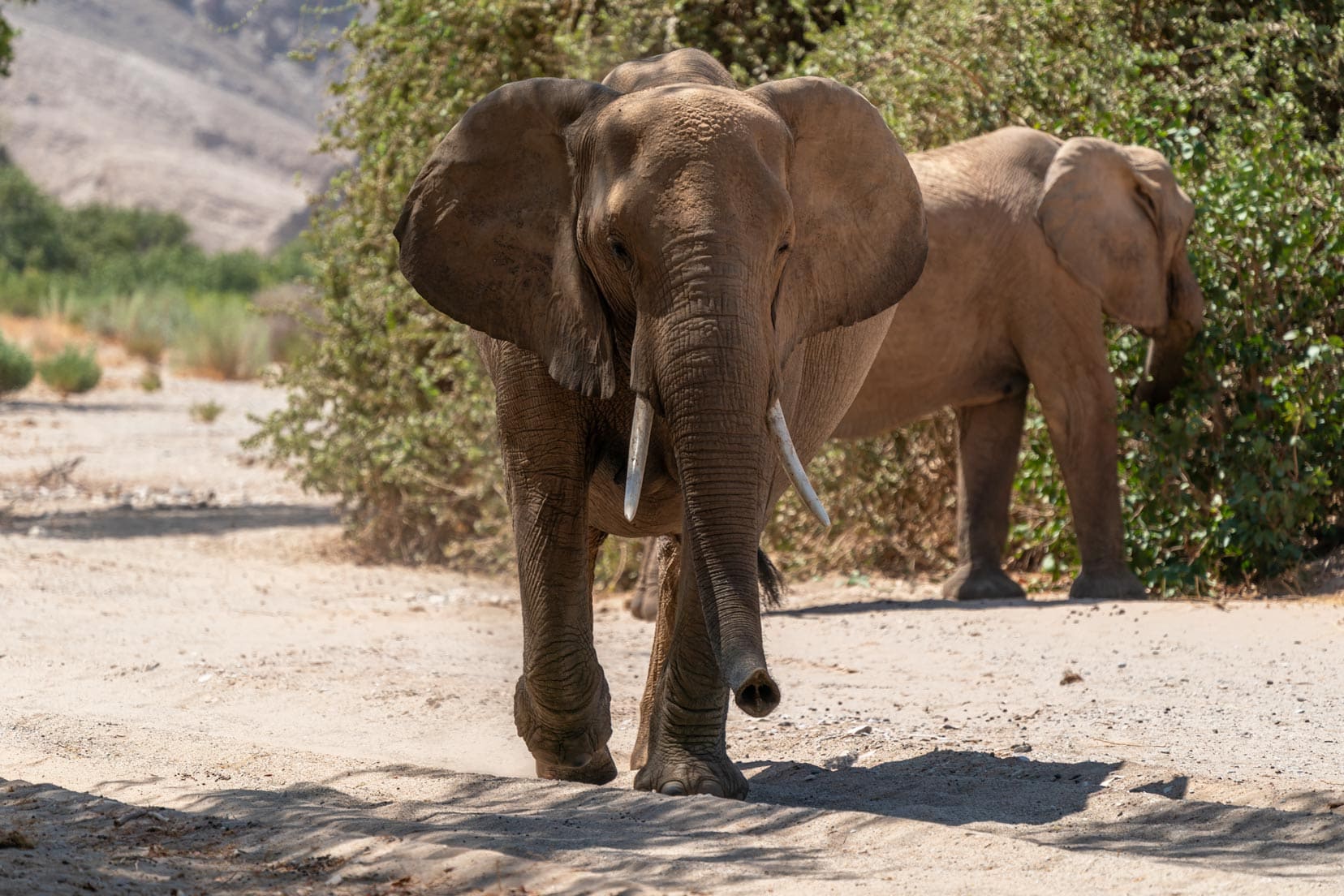
Map: Finding Desert Elephants in Namibia
The map below indicates the locations of our elephant sightings:
The coloured map markers represent:
- 🟢 Green: campsite
- 🔵 Blue: route marker
- 🔽 Grey: attraction
- 🌕 Yellow: our desert elephant sightings
- 🟠 Orange: a driving route that was attempted but did not succeed
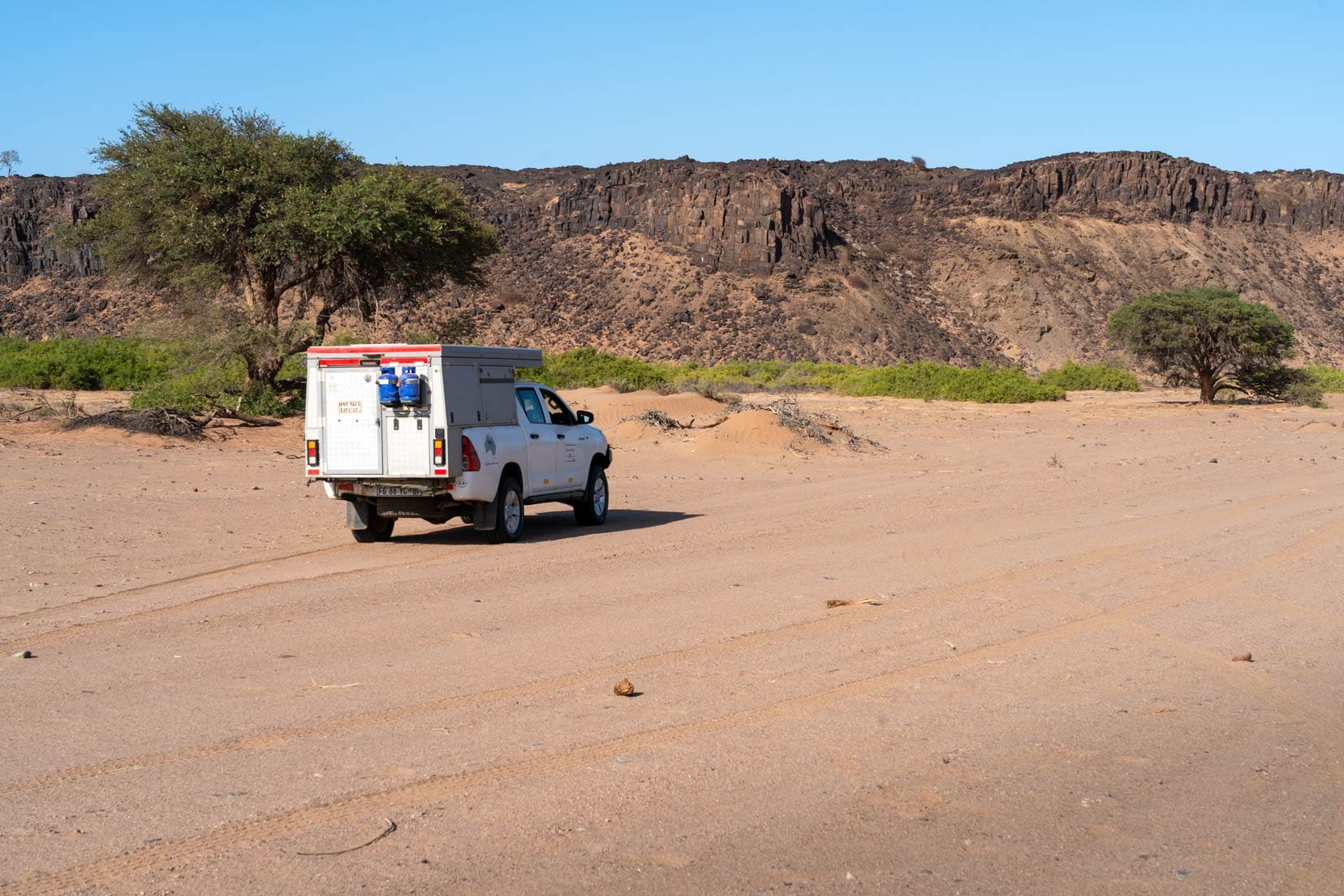
💡 For a comfortable and immersive desert stay further south in Namibia, consider the Kanaan Desert Retreat, where you may just encounter a merry mob of meerkats. Another animal well adapted to the Namibian landscape.
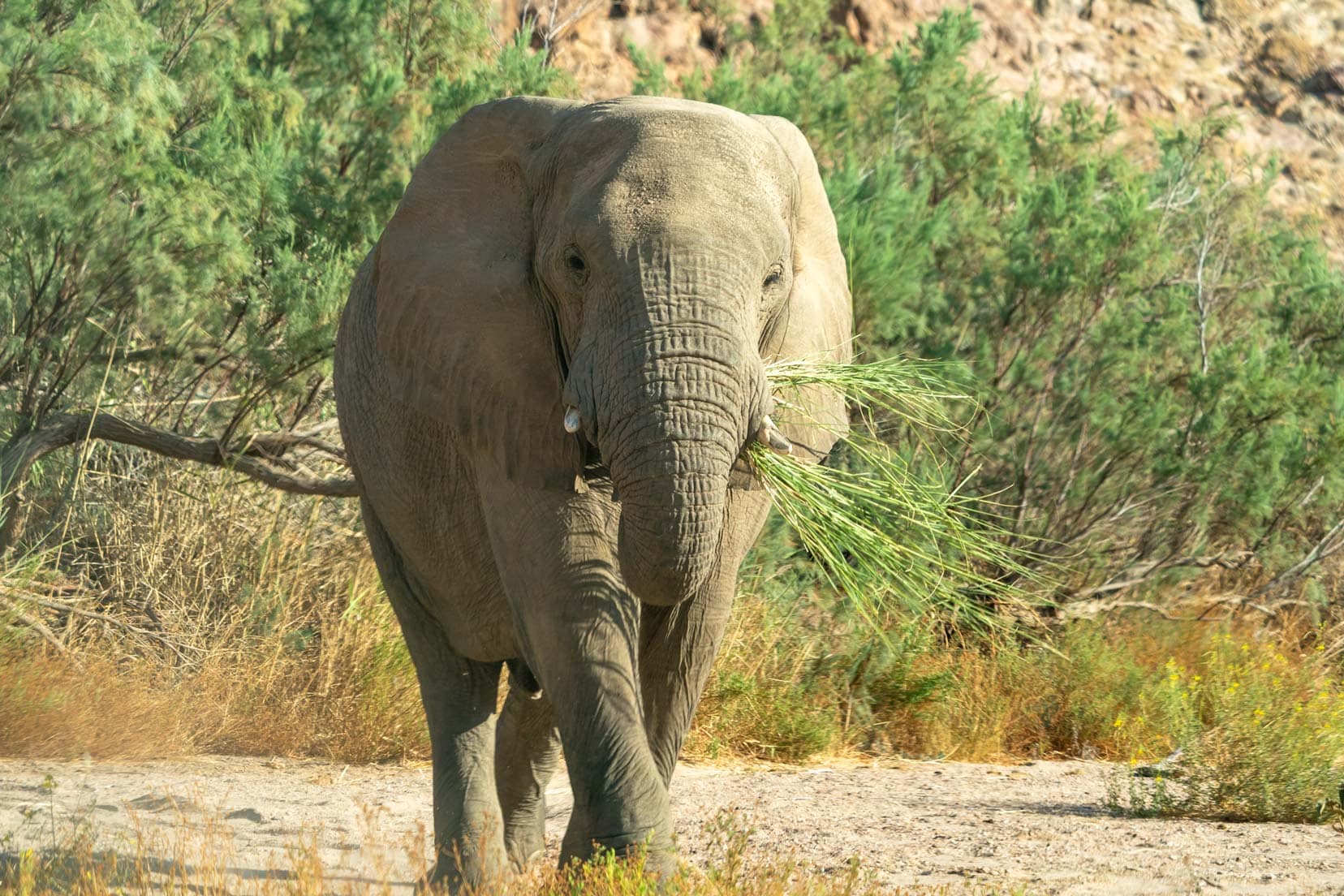
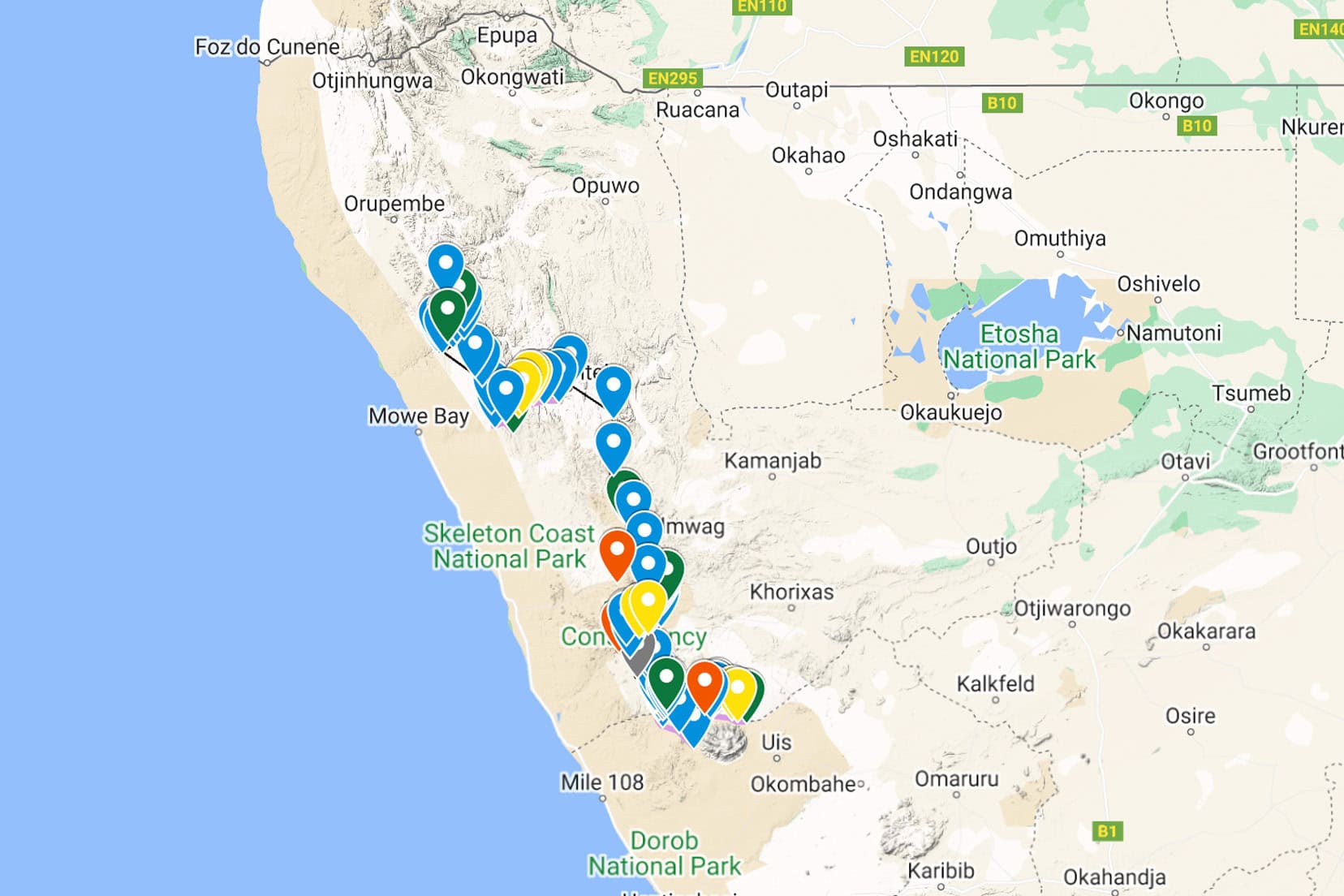
Planning Your Travels to Namibia?
- 🏥 Travel insurance: We recommend World Nomads or Safetywing
- ✈️ Flights: Use Skyscanner for flight booking deals
- 🚘 Need to hire a car? We use and recommend DiscoverCars
- 🚐 Camper Hire: We recommend Motorhome Republic
- 🪪 Need an International Driver’s License? Order online here
- 🐕🦺 Pet Care: Use TrustedHousesitters and have an animal lover look after your pet for FREE (Use our Discount code: LIFEJOURNEY25 for 25% off)
💡 Before or after your elephant adventure, explore the unique attractions of Luderitz on the south coast. Also, don’t miss the enigmatic old diamond mining town – Kolmanskop Ghost Town, a short drive from Luderitz.
About Namibia’s Desert Elephants
Namibia, a land of stark beauty and contrasting landscapes, is home to one of the planet’s most extraordinary creatures – the desert elephant.
These giants have adapted to the Namib Desert’s harsh conditions, showcasing nature’s resilience and adaptability.

Desert elephants, a wonder of evolution, have developed unique behaviours to survive in the arid desert environment.
They can traverse vast distances in search of water and food. They travel over 70 km from the Hoarusib River to the Hoanib River in search of the Ana tree seedpods.
And that’s just one of their attributes.
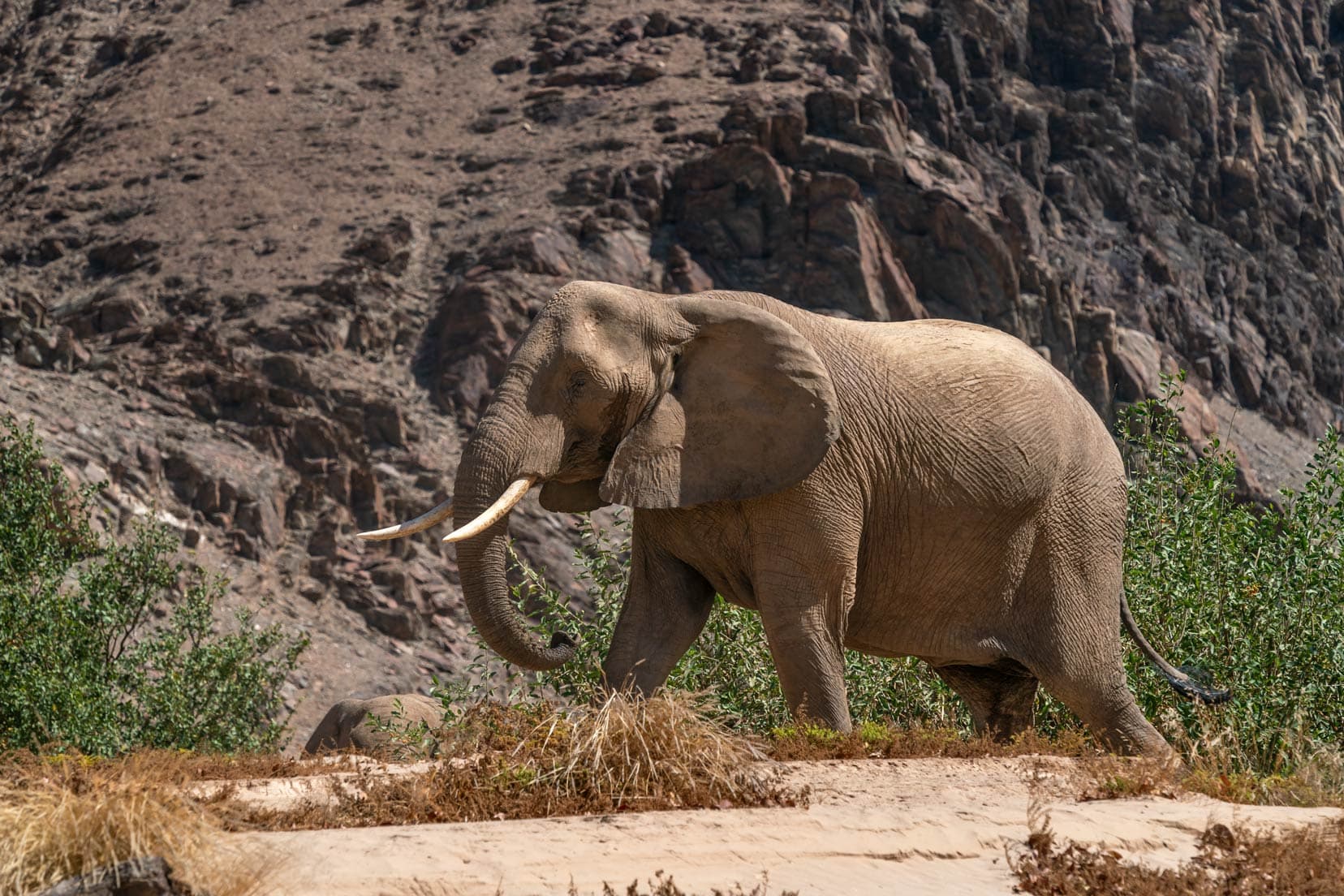
They are able to go without a drink for several days, exemplifying their adaptability. Also, the desert elephants’ feet seem wider than their savannah brothers, which helps them navigate the sandy terrain.
Surprisingly, when comparing the body sizes of the desert and savannah elephants, males and females are more or less the same.
Video: Our Amazing Desert Elephant Encounter
Our GoPro video below of our up-close encounter with the desert elephants Namibia encounter in the Ugab River. Turn the volume up for this one.
Where Can I Find Desert Elephants in Namibia?
You’ll certainly want to know where to find desert elephants in Namibia.
Well, Namibia’s desert elephants once roamed a massive area. From the Kuiseb River (in the west-central part of Namibia) to the Kunene River (at Namibia’s northern border with Angola).
In the 18th century, it is estimated that a few thousand desert elephants roamed the original area.
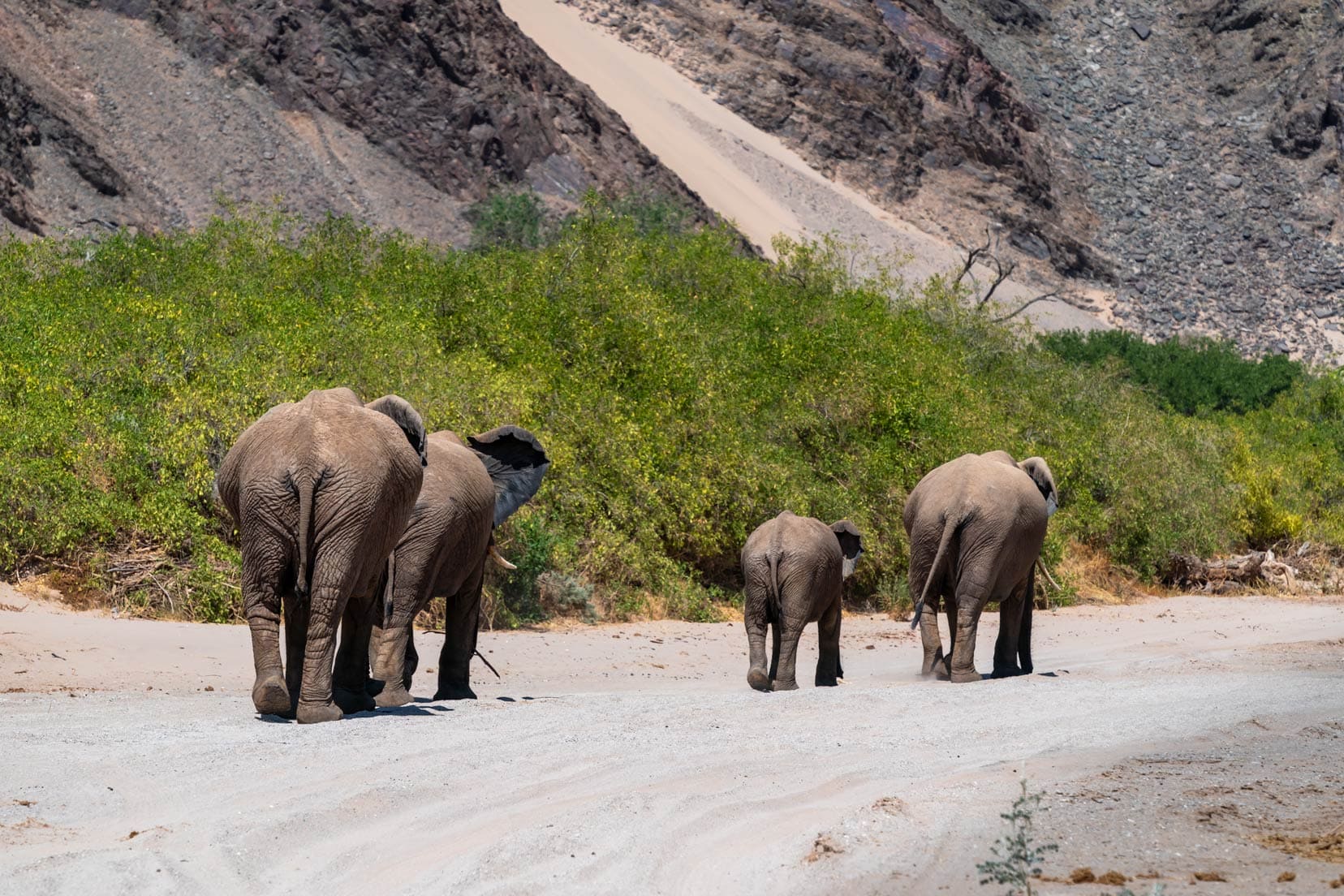
Sadly, there are now fewer than 200 desert elephants in Namibia.
These are concentrated around just five rivers on Namibia’s west coast:
- Ugab
- Huab
- Uniab
- Hoanib
- Hoarusib
Of these 200 remaining elephants, less than 60 inhabit the Ugab and Huab river regions. Reduced numbers driven by human-elephant conflict and climate change.
Their survival is indeed in the balance.
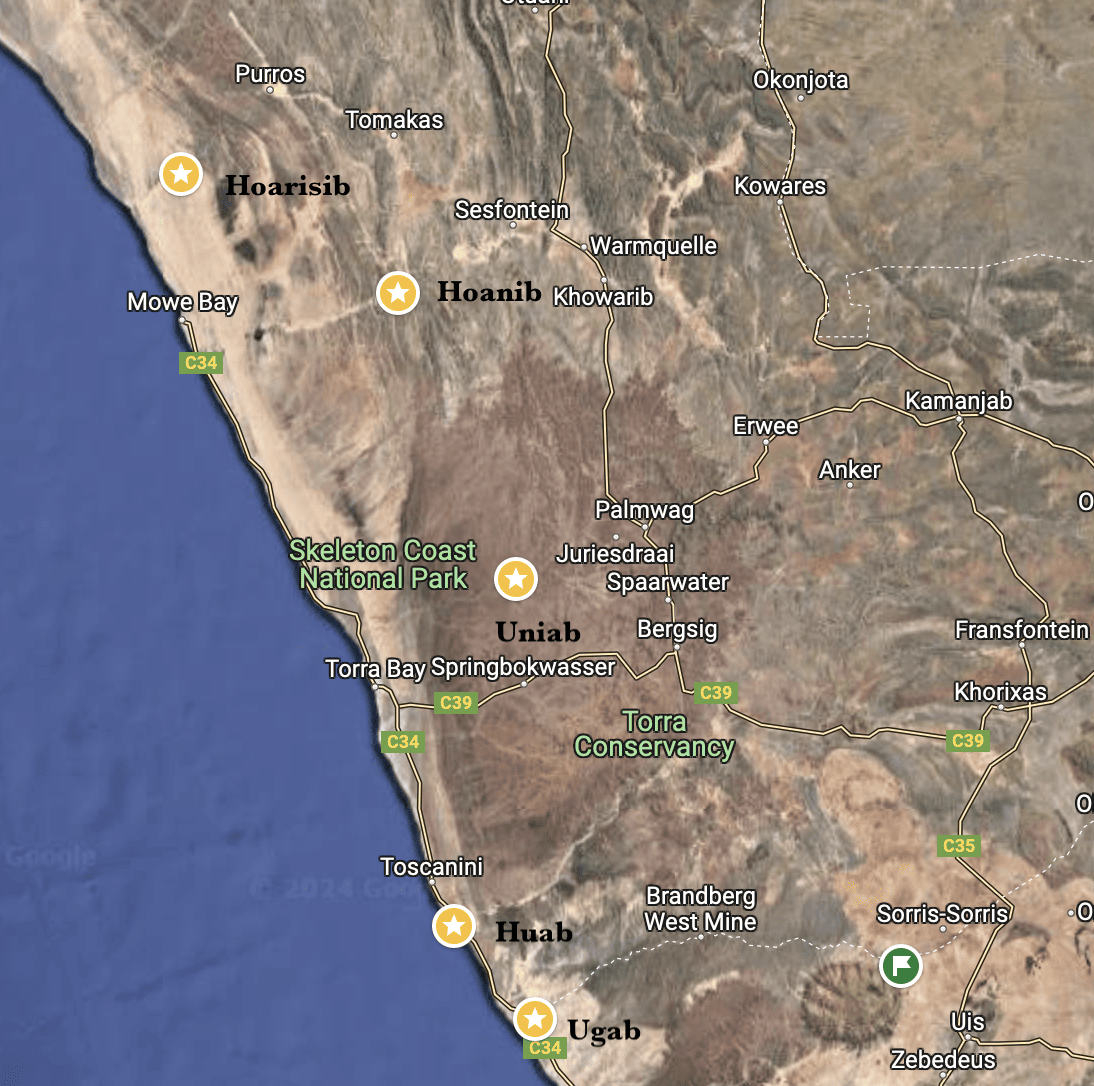
Conservation Efforts and Sustainability
Two main organisations are leading the desert elephant conservation efforts in Namibia. They are the Elephant-Human Relations Aid (EHRA) and the Desert Lion and Elephant Conservation.
These two main conservation organisations are responsible for different river systems.
EHRA
Elephant-Human Relations Aid (EHRA) is leading efforts to protect desert elephants in the Ugab and Huab river systems of the Southern Kunene and Northern Erongo regions.
These organisations are pivotal in easing the human-elephant conflict. This conflict primarily stems from a combination of habitat loss due to agricultural expansion and climate change.
However, the ongoing threat from poaching and previous wartime conflicts have also contributed to the marked decrease in desert elephant numbers.
Desert Lion and Elephant Conservation
This organisation focuses its conservation efforts on the desert elephants inhabiting the Hoarusib, Hoanib, and Uniab rivers located in the Western Kunene region. Their area also extends into the Skeleton Coast National Park.
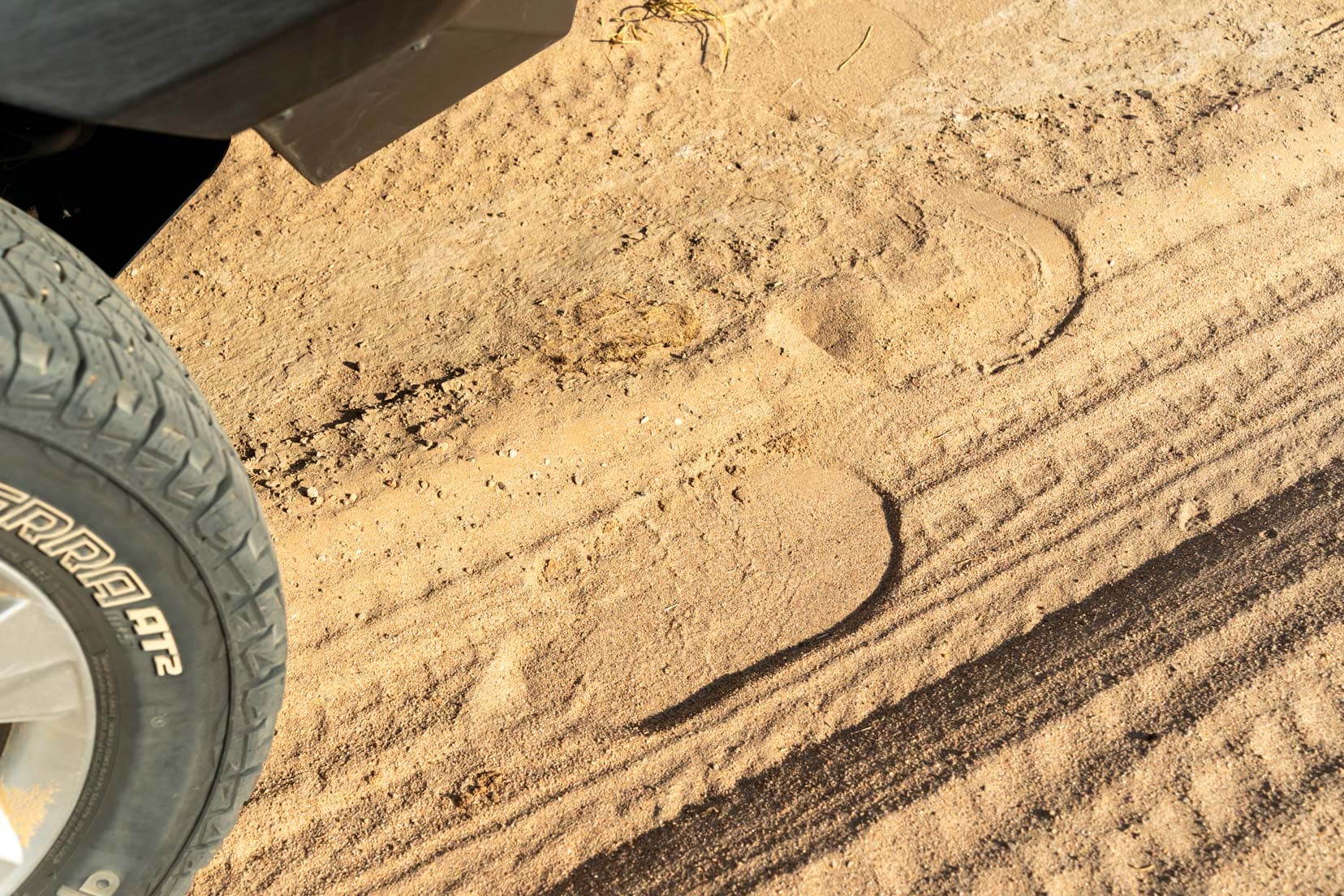
Collaboration between conservationists and local communities is key to safeguarding these elephants and their natural habitats.
Supporting these efforts, whether through donations, advocacy, or responsible tourism, is vital for the future of these gentle giants.
In understanding the desert elephants of Namibia, we come to appreciate not only their unique adaptations and ecological importance but also our role in ensuring their continued survival.
As we learn more about these magnificent creatures, we are reminded of our connection to the natural world and our responsibility to protect it.
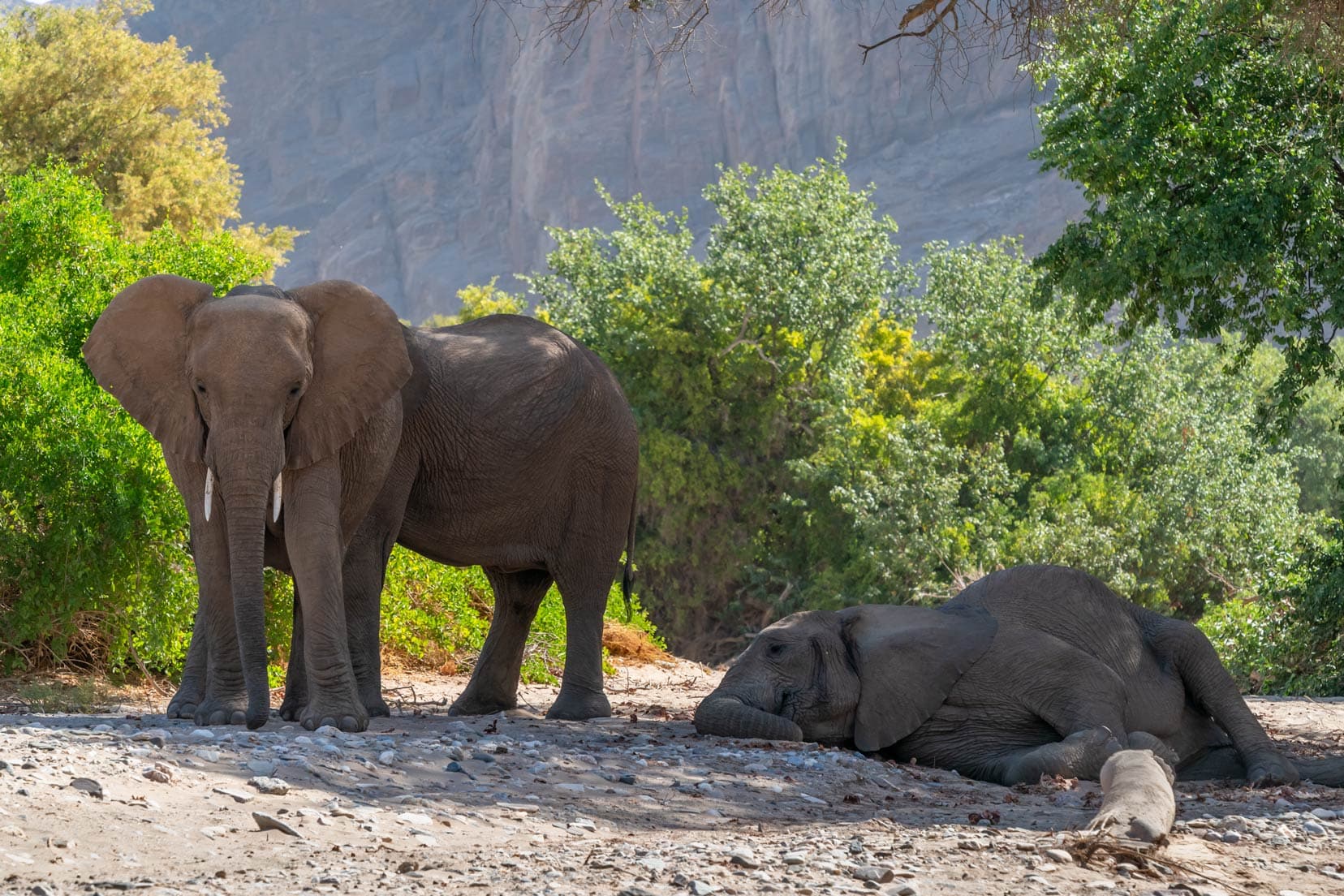
How Do You Search for Desert Elephants?
To find desert elephants, there are really only two options to consider:
1. Self-Drive with 4×4
Owning our South African registered Hilux 4×4 made life easy for us; however, the other great self-drive option is to hire a 4×4.
This is very popular for short-term visitors to southern Africa.
🚐 Thinking of Hiring a Camper in Namibia?
We recommend using Motorhome Republic to find you the best deal – they search all the local reputable African rental companies, including the most popular (we’ve seen them everywhere here), Avis and Britz
They do all the hard work for you and have a PRICE BEAT GUARANTEE
We bought our Hilux from Bushlore, which also specialises in hiring out their large range of 4×4 vehicles. I only mention Bushlore as this is the only 4×4 hire company we’ve had dealings with.
There are quite a few hire companies to choose from in Namibia, and Motorhome Republic can find you the best deal with the main ones like Avis and Britz.
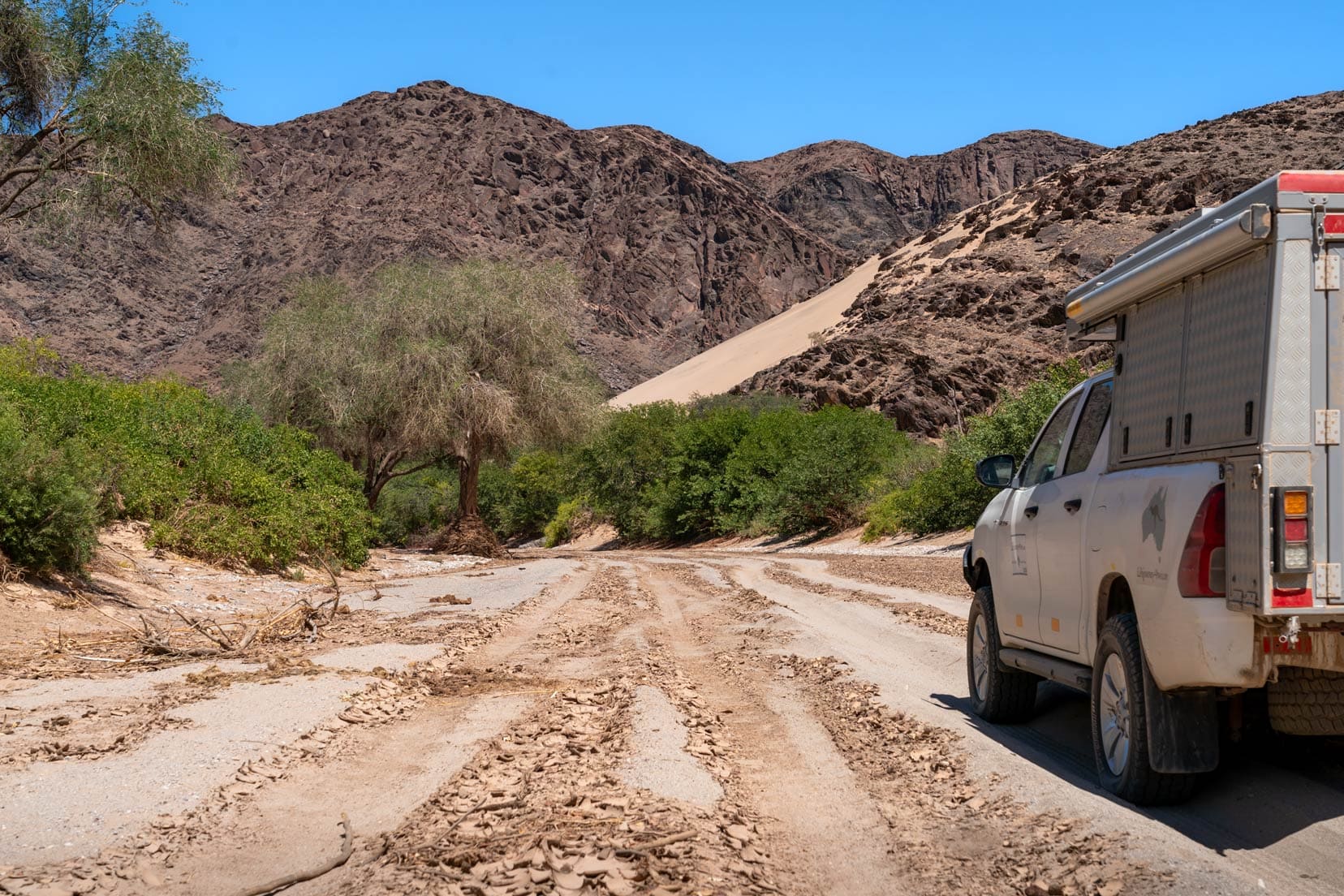
Self-Driving the Dry River Beds
If you’re planning your self-drive trip, our article on how to navigate these dry riverbeds will be invaluable. It includes our experiences of:
- Trip planning: what I did to plan the trip and what I needed to change along the way
- Driving: includes info on driving the dry river beds and getting from river to river
- Route selection: navigation systems and the route options we chose
- Campsites: what was the location of our campsites, and why did we choose that spot?
- Hazards: what to be aware of and what I’d do differently.
- Video footage: from our GoPro and iPhones.
As with all our southern Africa travels, we rely on the fabulous Tracks4Africa app to keep us on, and sometimes off, track!
2. Join a Game-Drive
If you don’t want to self-drive, joining a guided tour is another option for a great experience.
Local guides have invaluable knowledge about the elephants’ movement patterns. They can also provide insights into the elephants’ behaviour, which can further enhance your knowledge and experience.
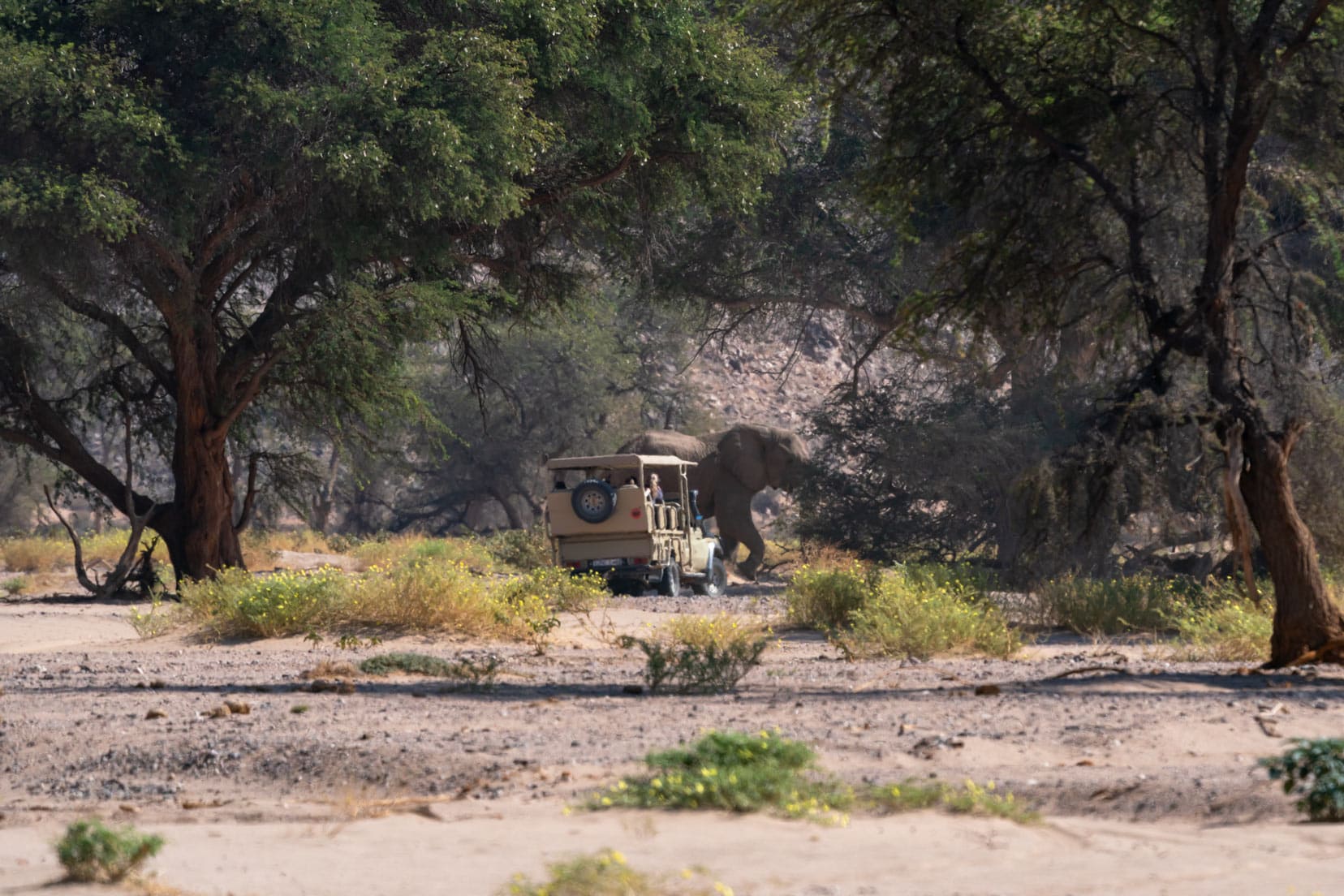
Of the four rivers we drove, the only game-drive vehicles we saw were at the Huab River. However, game drives are available for each of the five rivers (Ugab, Huab, Uniab, Hoanib and Hoarisib).
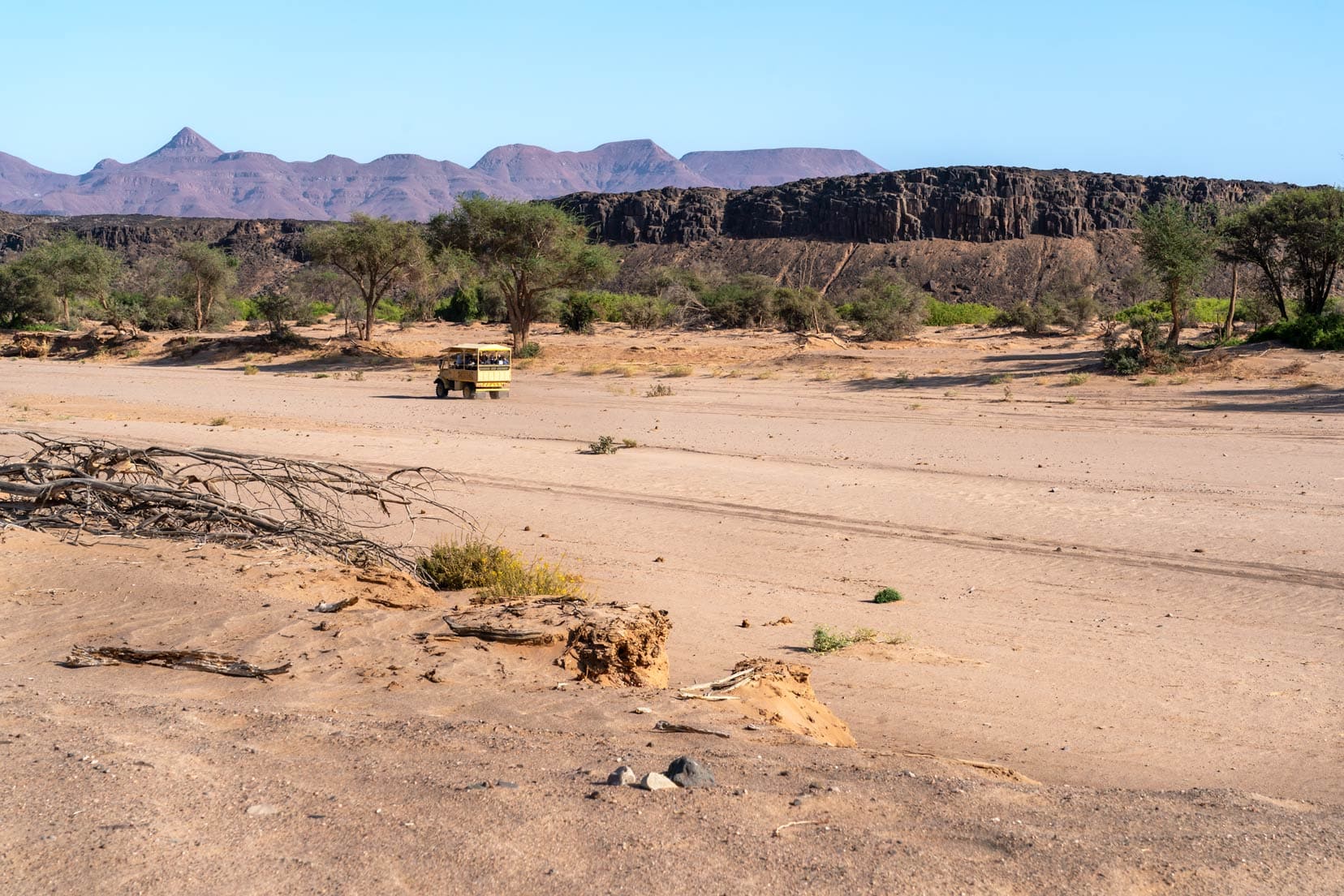
Staying at a lodge or camp close to the rivers is best to maximise your time on a safari. We spent two days driving each of the river beds.
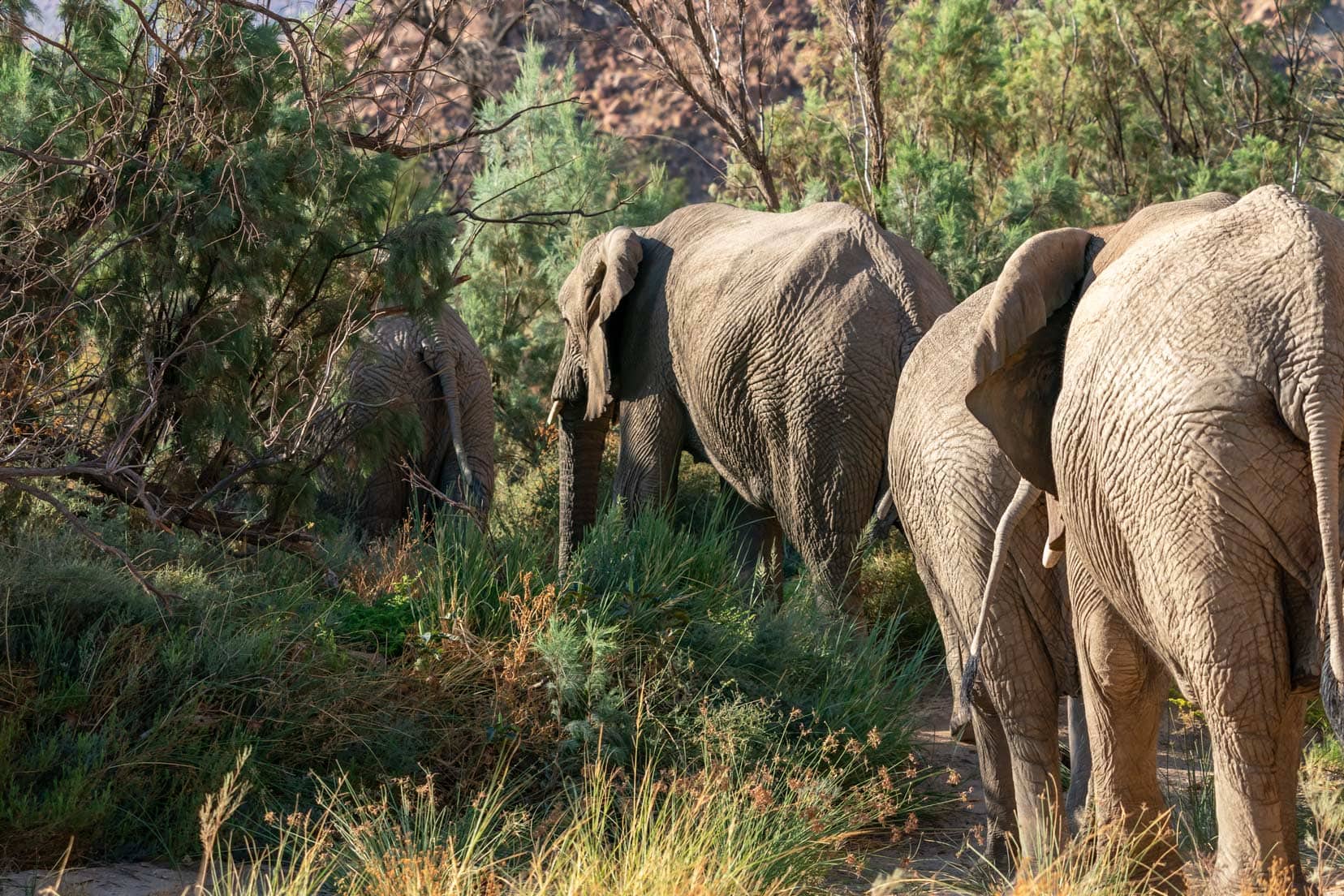
Our Desert Elephant Sightings
Our drive of the riverbeds began in the south at the Ugab River. We camped each night, taking 10 days to drive the Ugab, Huab, Hoanib and Hoarisib rivers.
Each day, we would start early, hoping to catch a glimpse of any of the local wildlife.
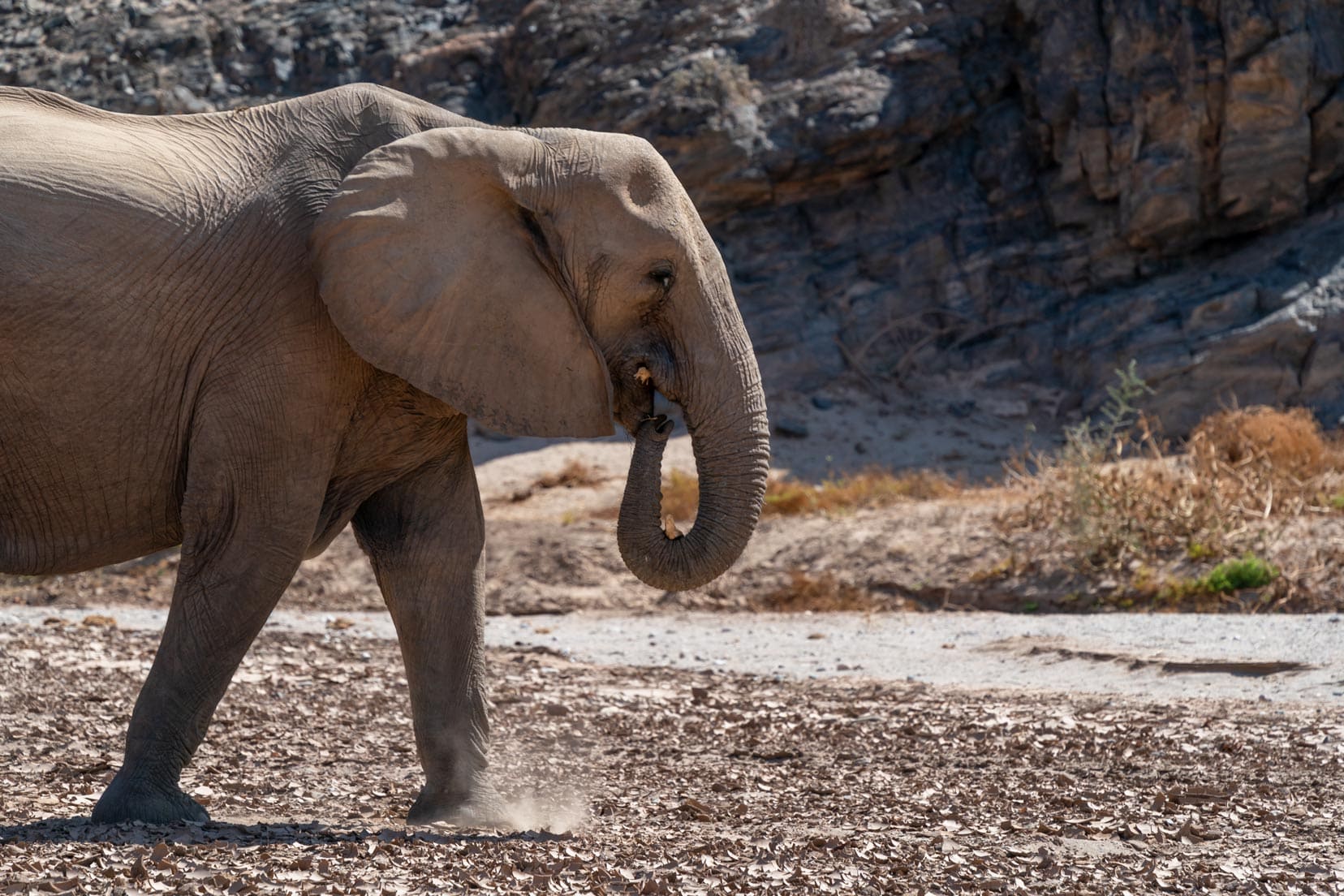
Our method was to drive slowly on each of the riverbeds, stop frequently with the engine off and listen. The waiting game is one you want to master in Africa.
Sometimes, other game-drive vehicles on the river would stop, with the driver either asking or informing you of elephant sightings.
Even though we drove long distances between the rivers, all our desert elephant sightings were in the riverbeds and not between the different river systems.
We experienced great desert elephant sightings in the Ugab, Huab, and Hoanib river systems. We did not drive Uniab and did not have any sightings in Hoarisib. However, we were told by the local camp attendant that elephants had passed by the camp during the night.
Best Time of Year to Spot Desert Elephants
Embarking on a journey to witness Namibia’s desert elephants is a unique wildlife-viewing experience. Here’s some advice to improve your chances of seeing these magnificent animals in their natural habitat.
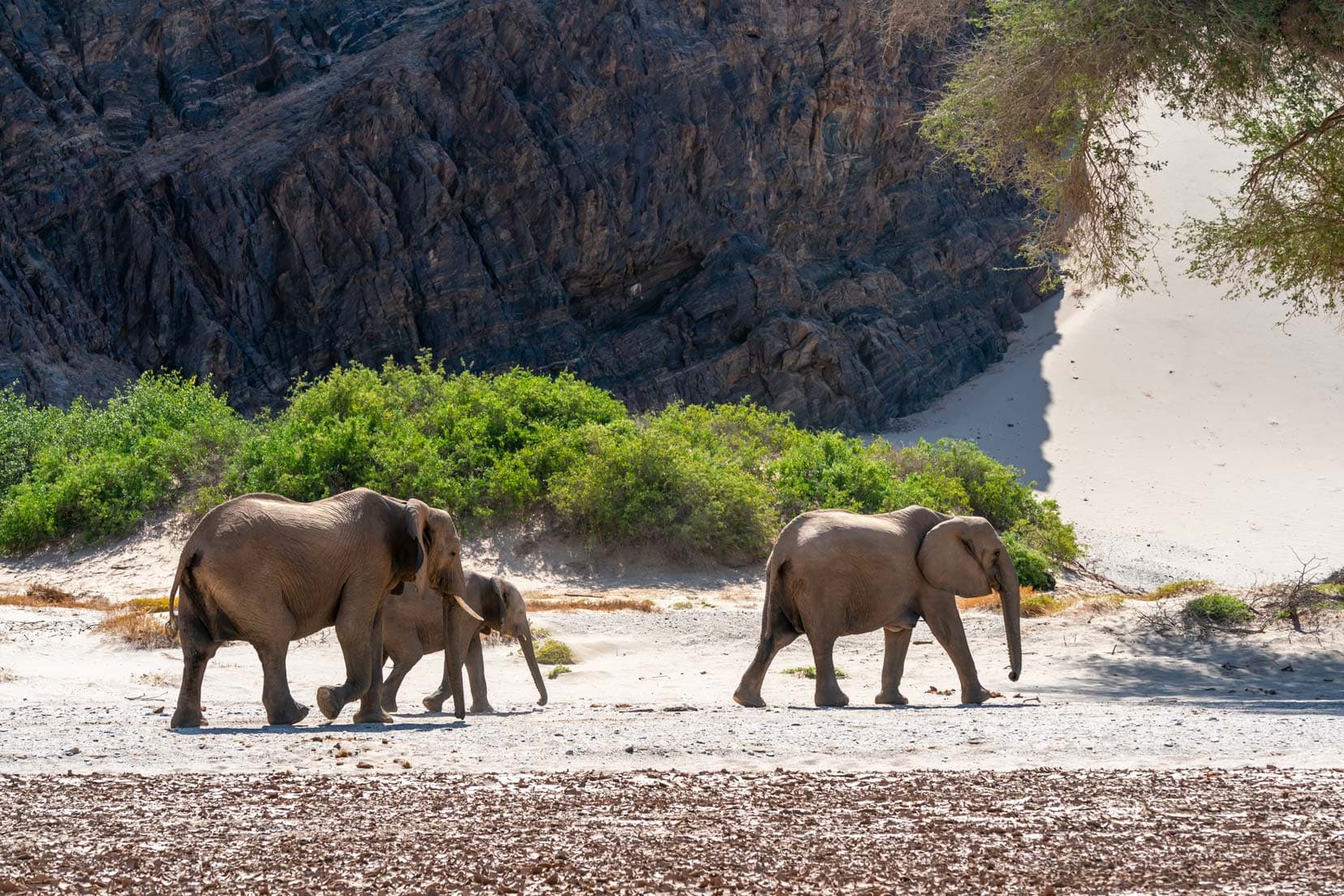
Choose the Dry Season – The Ideal Time
The dry season, from May to October, is generally considered the best time to spot desert elephants. This is because elephants are more likely to congregate around known waterholes and rivers as water sources become scarce.
This often, but not always, opens up the possibility to drive the dry riverbeds.
However, even though it’s the dry season, you still need to keep an eye on the weather as the riverbeds can flood easily in wet weather, making for dangerous conditions.
During our April visit, the usual Summer rains did not arrive, so the riverbeds were mostly dry, allowing us to drive the soft river sand. It wasn’t without incident, though. We got bogged in the powdery river sand a couple of times.
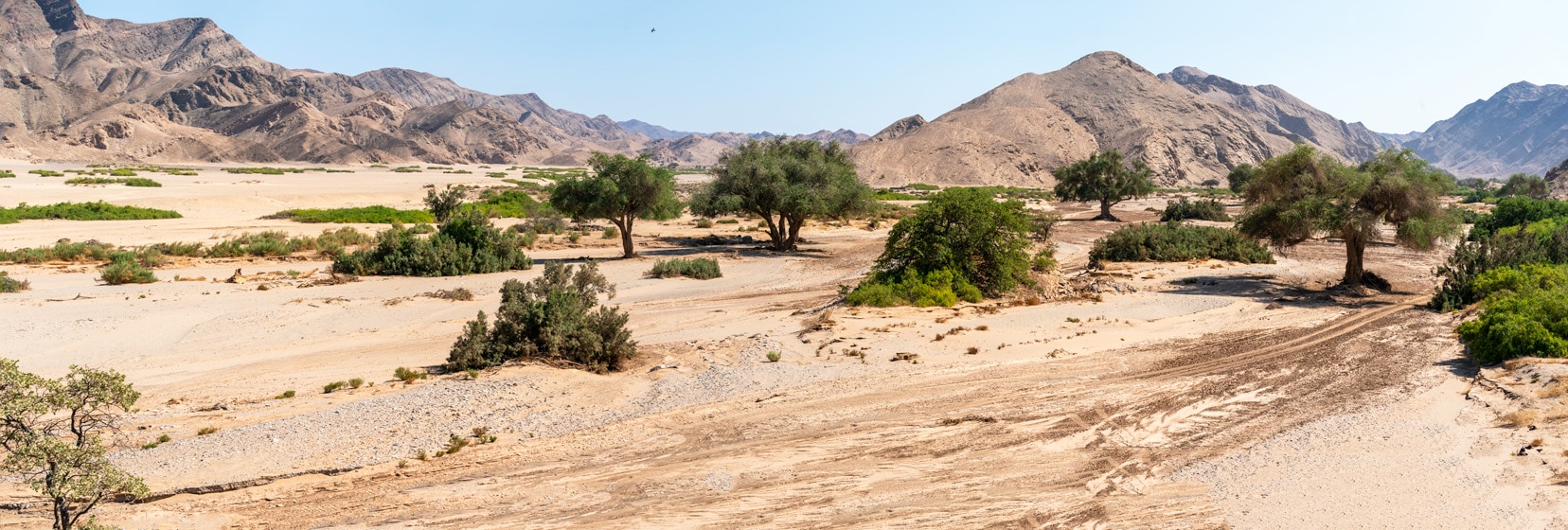
Early Mornings and Late Afternoons for Better Sightings
Like many wildlife species, desert elephants are most active during the cooler parts of the day. We saw this first-hand when elephants would often shelter under trees or even lie down to sleep during the hotter times of the day.
Yes, you read it right: elephants lying down to rest. It was the first time in Africa that we’d seen this phenomenon. Not the whole herd, normally just one or two animals that felt the need to get horizontal.
The others would be standing close by, waiting for the sleepers to awake.

Respectful Viewing of the Desert Elephants
Remember, the welfare of the elephants should always come first.
- Don’t crowd them, as this causes distress to the elephants
- Keep a respectful distance
- Minimize noise, and
- Never attempt to feed or touch the elephants.
Responsible viewing ensures a safe experience for both you and the animals.
Our tried and trusted method is to park at a distance of 50m or more with the engine off. Using our binoculars and telephoto camera lenses allows us to observe the elephants from a safe distance, minimising any disturbance.
During our travels in Africa, we’ve observed that elephants are naturally curious and often approach for a closer look.
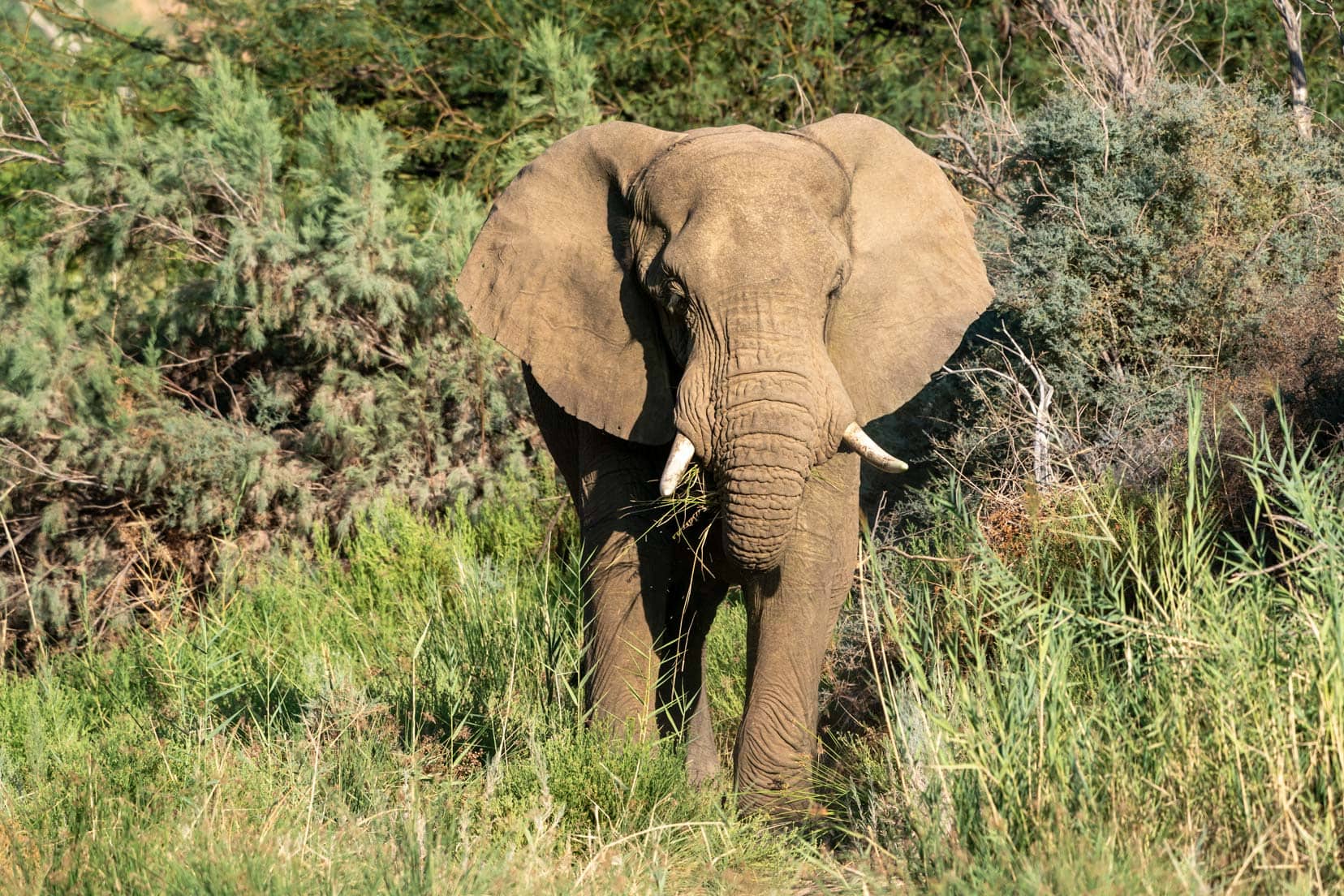
Photography and Equipment Tips
With all the effort taken to find the elephants, you’ll want to ensure you are ready to capture some great memories.
Here are some important photography and equipment tips:
- Binoculars: Have a good quality pair of binoculars with you. We find that 10×42 provides a good balance between magnification and the amount of light entering the front binoculars lens.
- Sun Positioning: Try to have the sun behind your shoulder to minimise the animal’s shadow in the photo. Positioning the vehicle position is important.
- Telephoto Lens: Using a telephoto lens will bring the action to you, meaning that you can park up at a distance from the elephant and minimise any disturbance. Don’t get out on foot.
- Bean Bag for Stability: Using a bean bag on the window sill to rest a telephoto lens is really helpful as it allows you to move the lens easily on a soft surface. We use bean bags all the time.
- Battery Life: Maintaining battery life is critical, so the use of a power bank for charging a mobile phone or plugging in a USB battery charger for camera batteries will ensure you are always ready to shoot.
- Lens Cleaning: The wind picks up fine dust particles into the air, which coats the lens on a mobile or camera. Keeping the lens clean is important for crisp photos. We use a blower, fine brush and microfibre cloth.
➡️ Check out the list of camera equipment we travel with, and also make sure you have proper safari accessories.
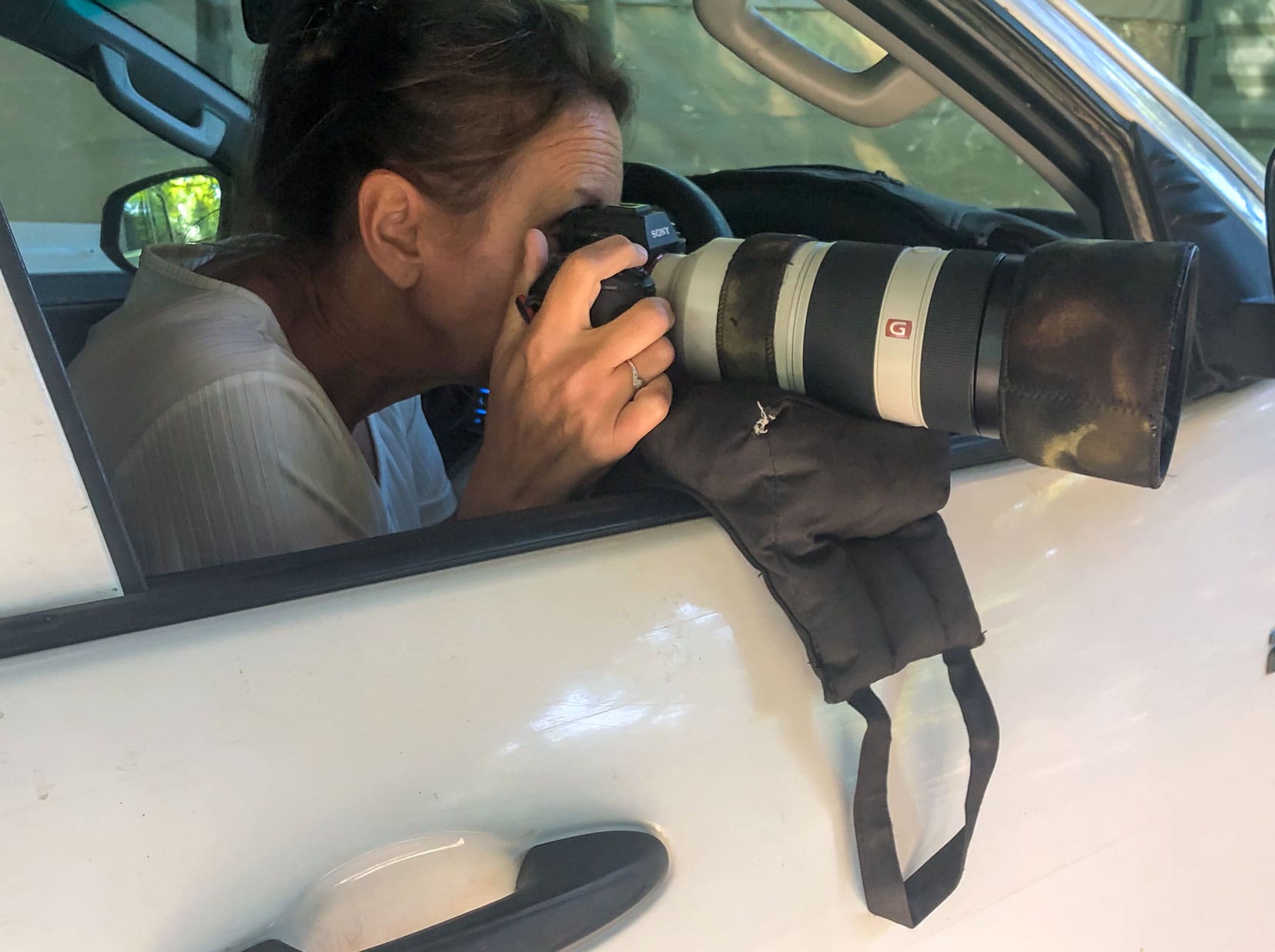
If you are a keen photographer, then while in Namibia, you’ll want to stop off at Sossusvlei. It was humbling to capture the enormity of these incredible shifting sand dunes and the unforgettable imagery of Deadvlei.
Travel Tips for Your Elephant Adventures
Embarking on an adventure to witness the majestic desert elephants of Namibia is an experience of a lifetime. To make the most of your journey, consider these essential travel tips.
1. Plan and Research
Allocate enough time in your schedule to sight any elephants in the desert. Sightings are not guaranteed, so we recommend spending at least two days at whatever river you visit.
Driving the riverbeds is only possible once the waters have receded. A good way to get first-hand information on the state of the rivers is to contact a nearby lodge.
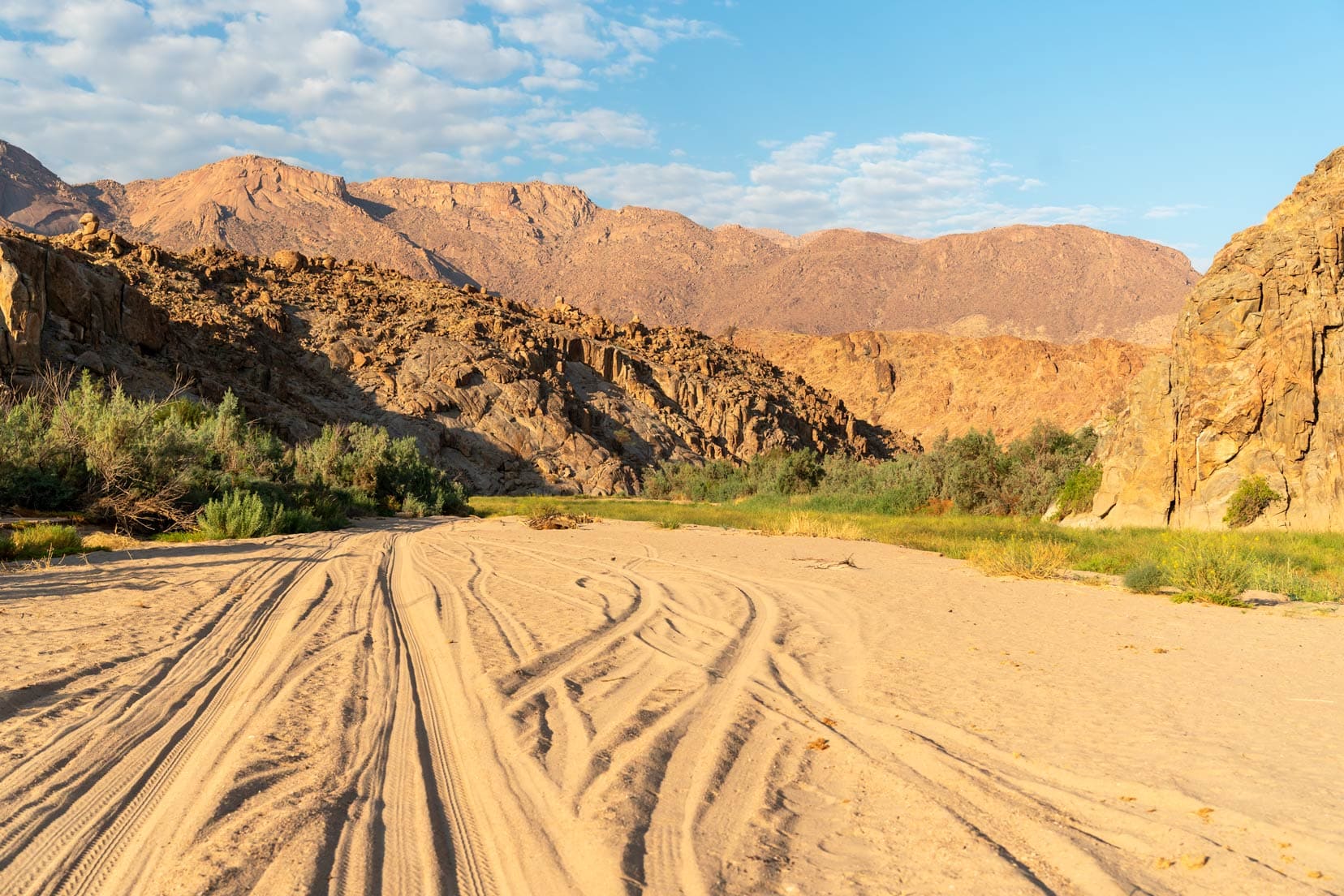
We were already camping at the Brandberg White Lady Lodge, so I asked the camp reception if the Huab River could be driven. I received the comprehensive answer of ‘maybe‘. It was not a particularly helpful response, so we proceeded anyway and found out for ourselves.
2. Pack Appropriately
The desert climate can be extreme, with hot days and cold nights. Pack lightweight, breathable clothing for the day and warmer layers for the evening.
Don’t forget sun protection, sunglasses and a good hat. Even in April, we found the midday temperatures to be very hot.
Our cooling towels, which we wet and tied around our necks, were a really useful and smart purchase. The towels take up very little space and are perfect for travelling.
For wildlife viewing, a good set of binoculars is an absolute must. Using these will definitely enhance your viewing experience, as will a camera with a telephoto lens.
Essential Gear for Your Desert Elephant Adventure
🧣 Cooling towels: Vital for staying cool in the intense desert heat.
🔦 Safari spotlight/torch and headlamp: Navigate safely during early mornings or late evenings.
👒 Safari hat: Essential for sun protection while exploring.
🥤 Water-To-Go and Lifestraw Go filter bottle: Ensure access to safe drinking water.
🔋 Portable power bank: Keep your devices charged on your adventure.
👕 Men’s Safari Shirt and Women’s Safari Shirt Choose lightweight and breathable fabric for comfort.
👖 Men’s convertible pants and women’s convertible safari pants: Stay adaptable to changing temperatures.
👀 Vortex Diamondback 10×42 PRO Binoculars: Get up close with distant landscapes and wildlife.
📷 Camera Gear: Don’t miss capturing the stunning dunes and desert landscapes.
🎒 Backpack: Carry all your essentials for a day trip comfortably.
For more detailed information on what to pack for a safari adventure, check out our Comprehensive Safari Accessories Guide.
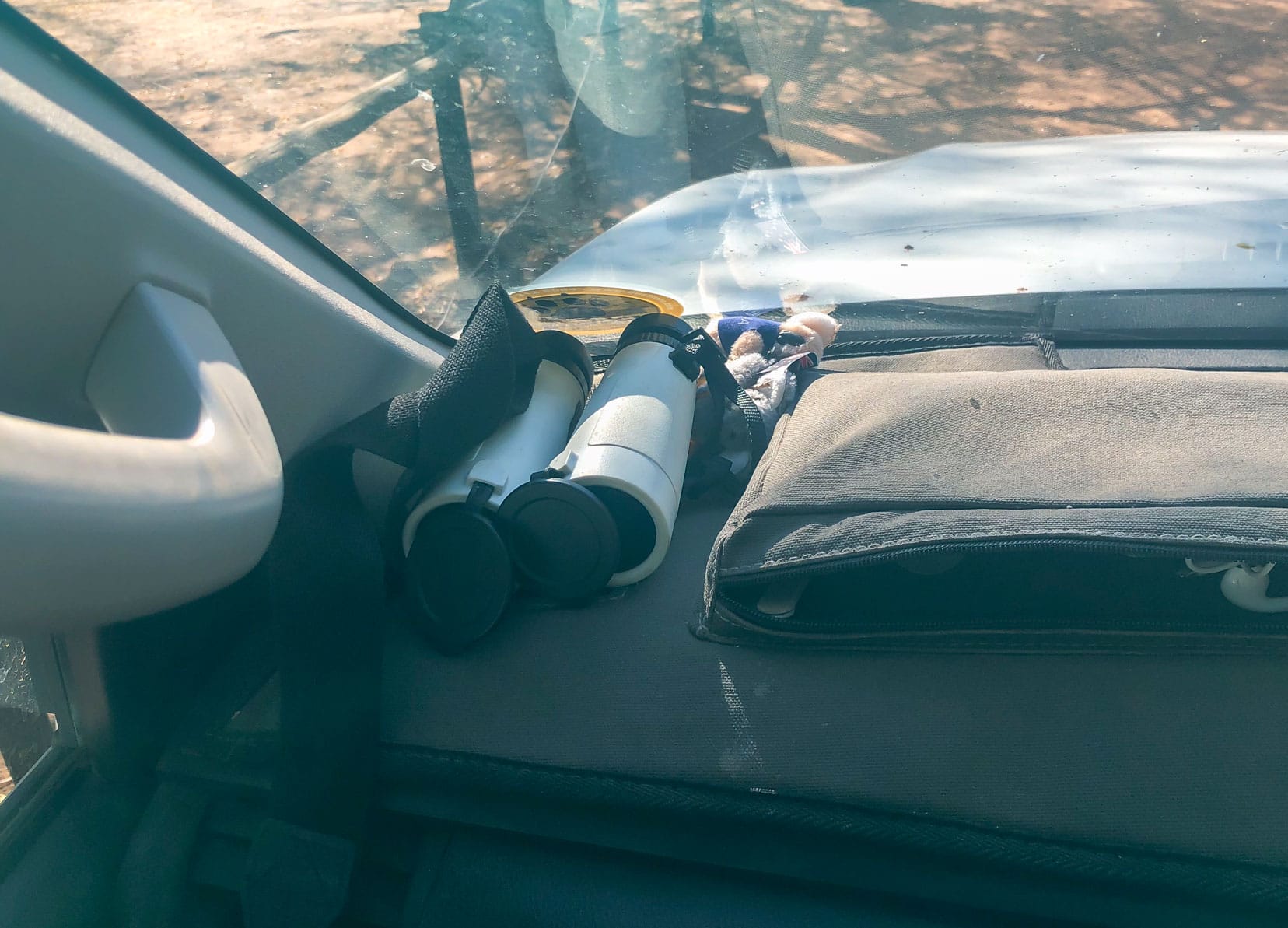
3. Stay Hydrated
Carry enough water to stay hydrated in the hot, dry climate. If self-driving these remote riverbeds, carry more drinking water than you think you need. We travel with a 20-litre Lifesaver filtered container and filtered drink bottles.
4. Respect Wildlife and Local Guidelines
Always follow the guidelines provided by your guides. Keep a respectful distance from the elephants and never attempt to feed or touch them. Your guide knows the best practices for a safe and respectful encounter.
5. Leave No Trace
Keep the wild in wildlife by leaving no trace of your visit. Take all rubbish with you and never remove anything from the natural environment. Your goal should be to leave the area exactly as you found it.
All our rubbish was collected in bin bags, which we kept until we passed through a town and then deposited. We only left tyre tracks and took away memories.
6. Support Local Communities
Supporting local communities by purchasing local crafts and using local guides contributes to the local economy, helping the elephant conservation efforts.
When driving the Hoarisib River north, we came across a small stall managed by four Himba children selling their homemade crafts. We bought some lovely bracelets and also gave them some food and water.
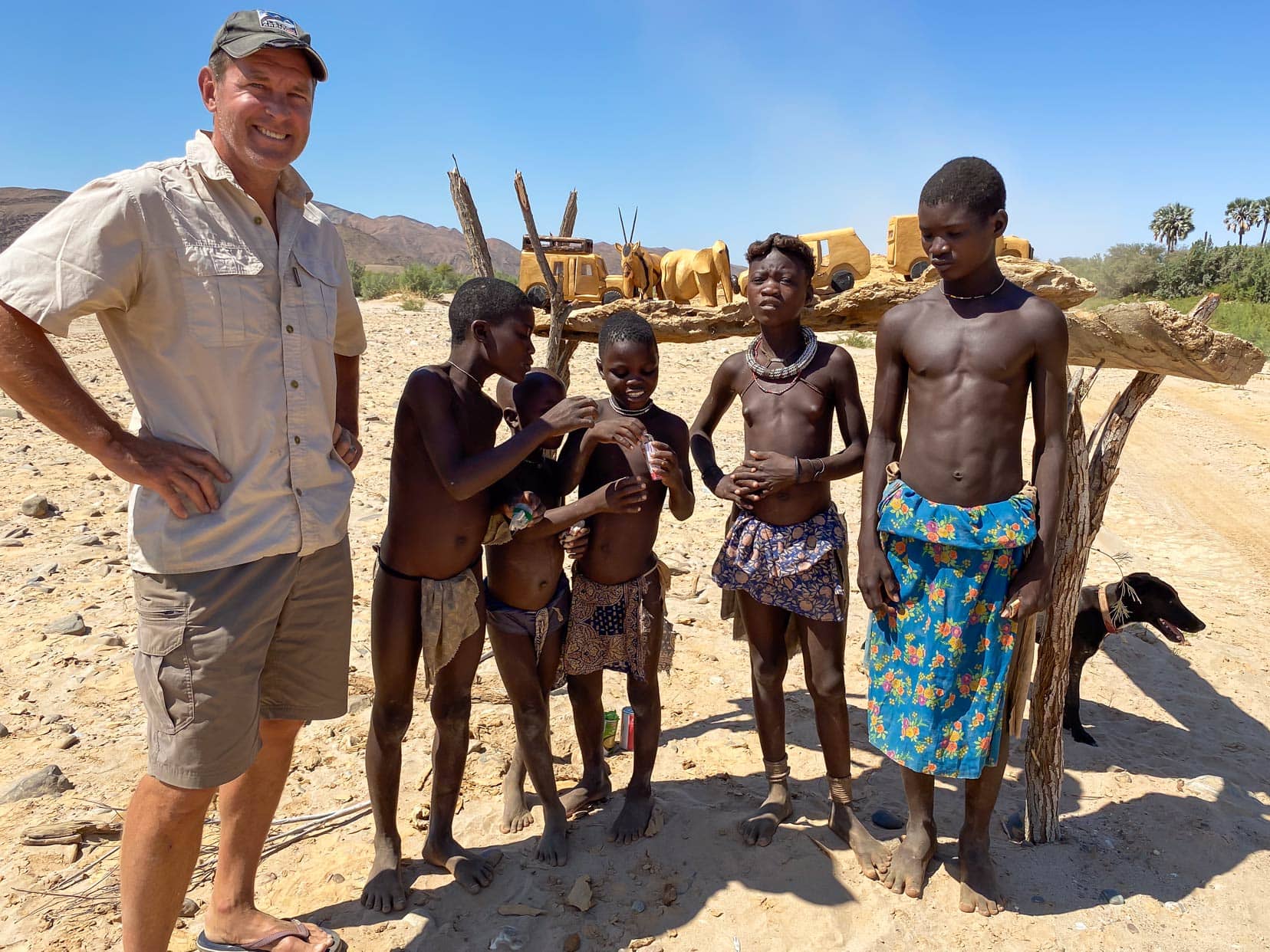
Other Desert Wildlife You May See
Whilst you’re waiting for the possible elephant sightings, don’t pass up the opportunity to look for other desert-dwelling animals.
Here’s a list of our Namibian wildlife sightings during our 10 days of overlanding through the Dry river beds:
Black-backed jackal
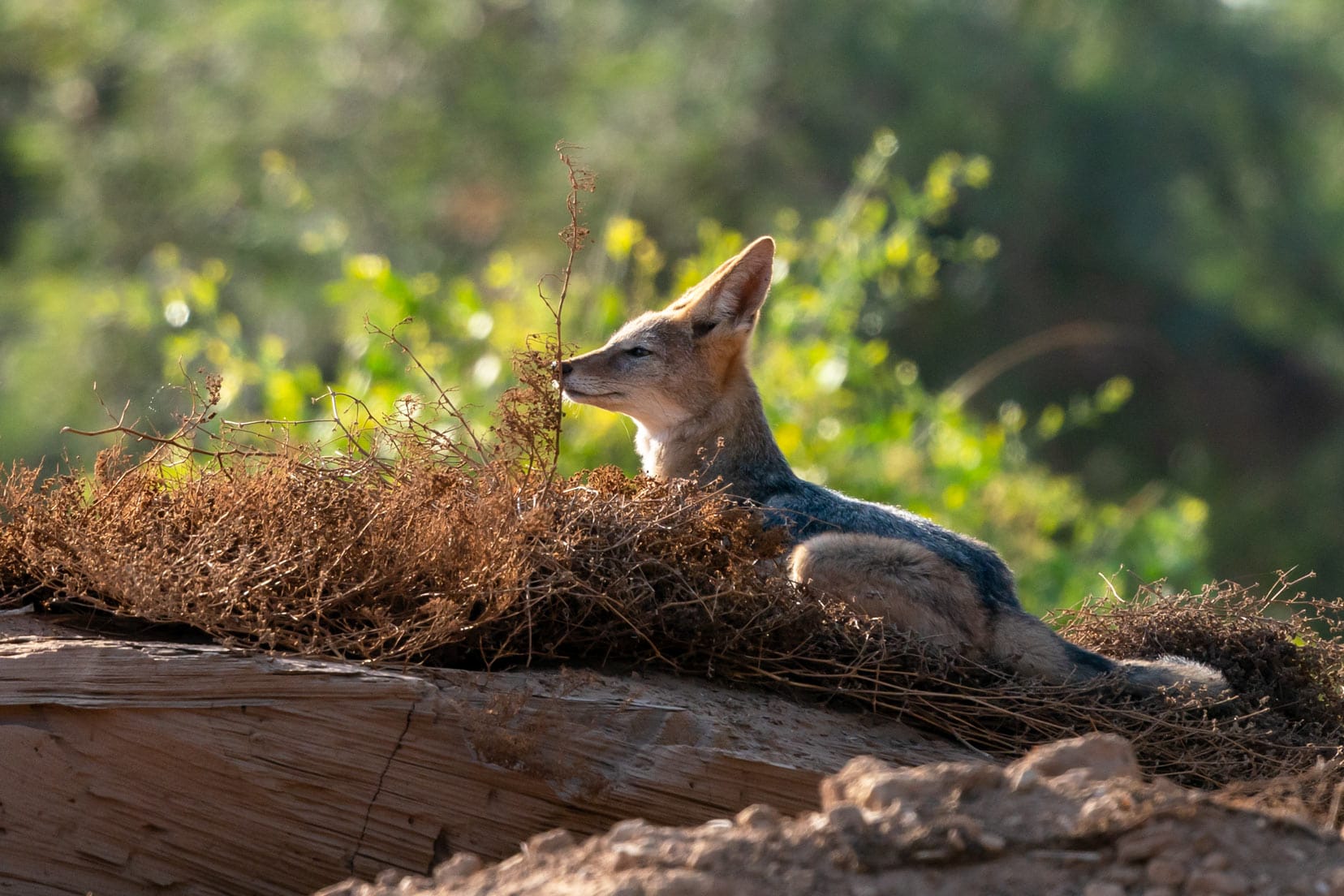
Giraffe
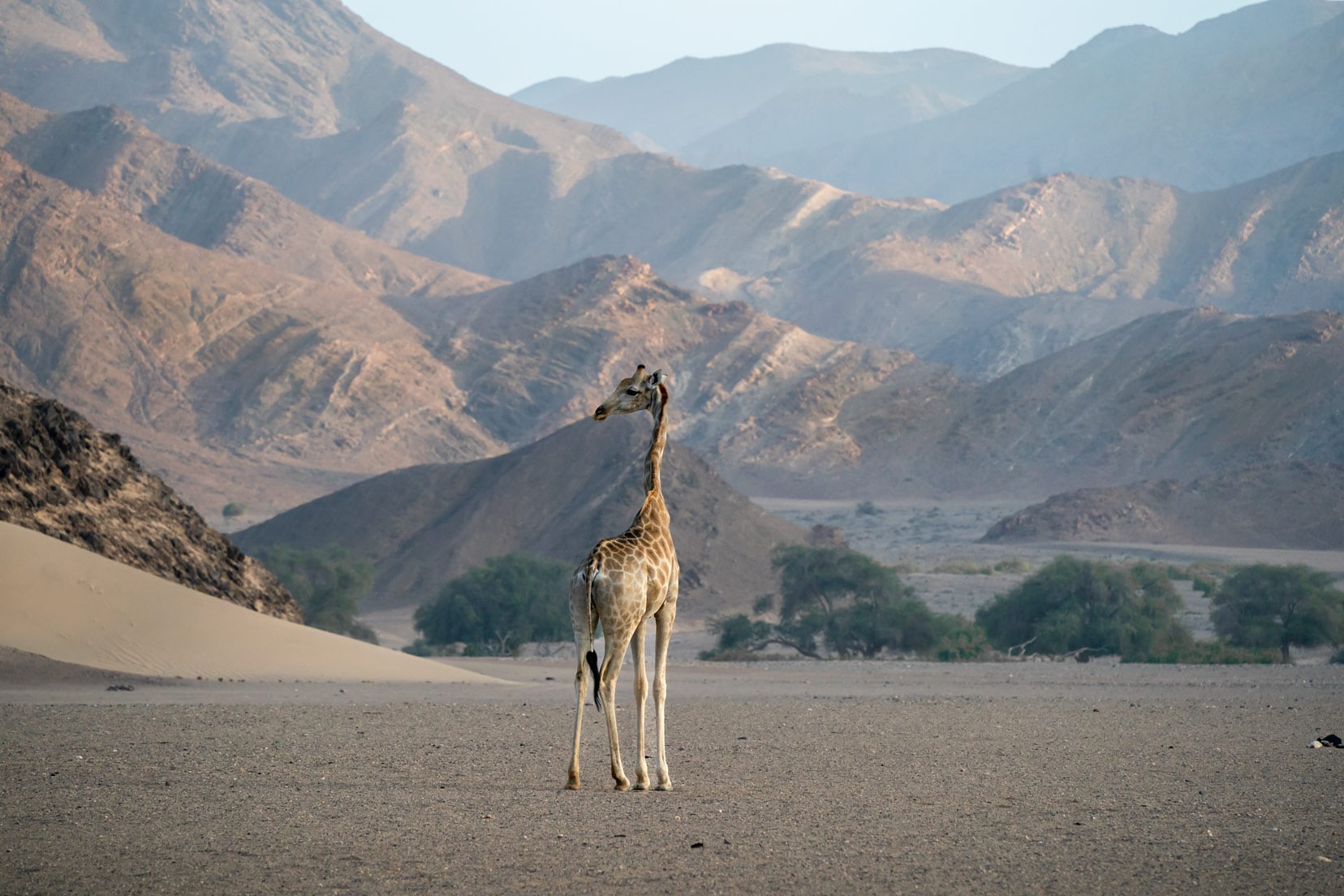
Oryx (Gemsbok)
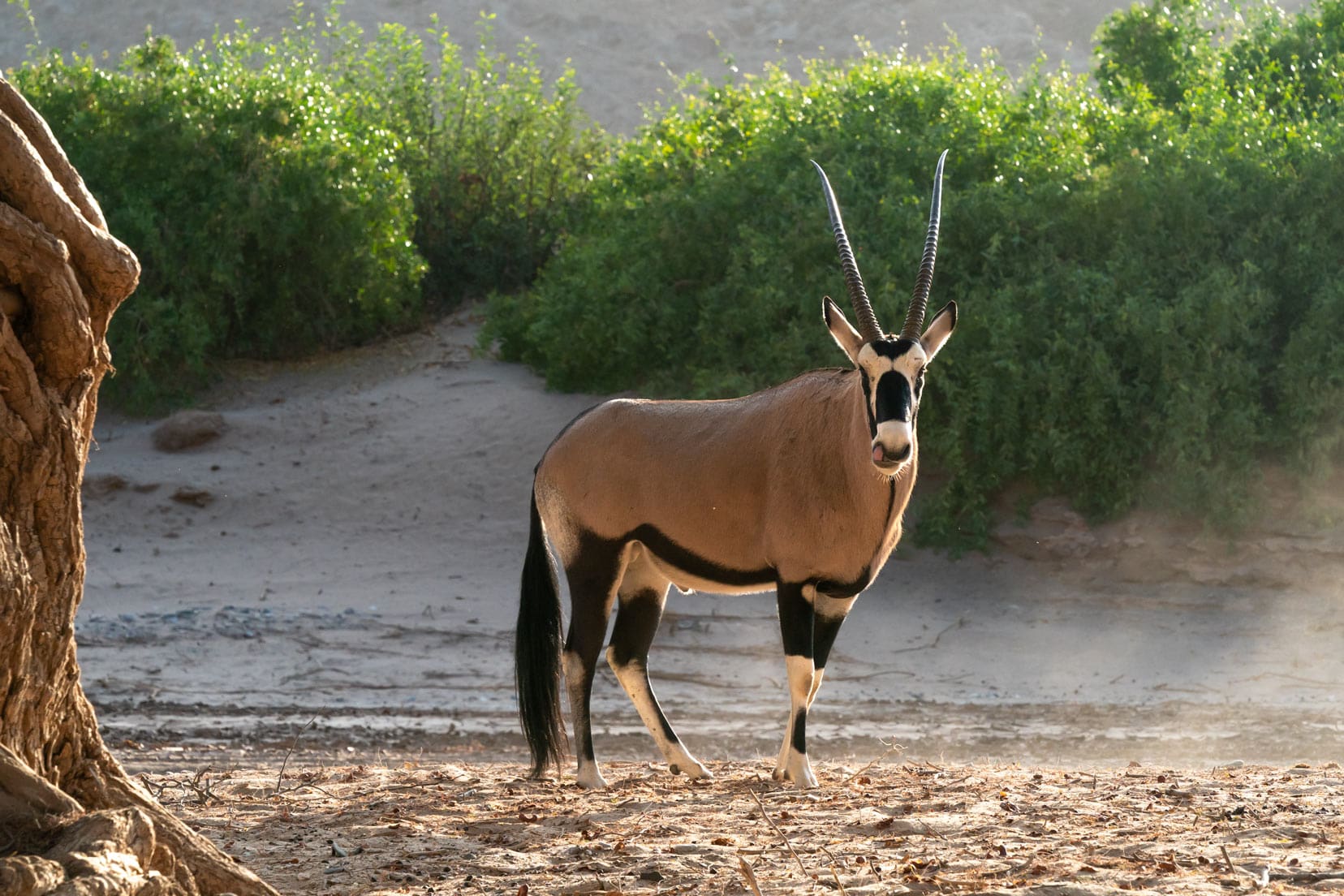
Springbok
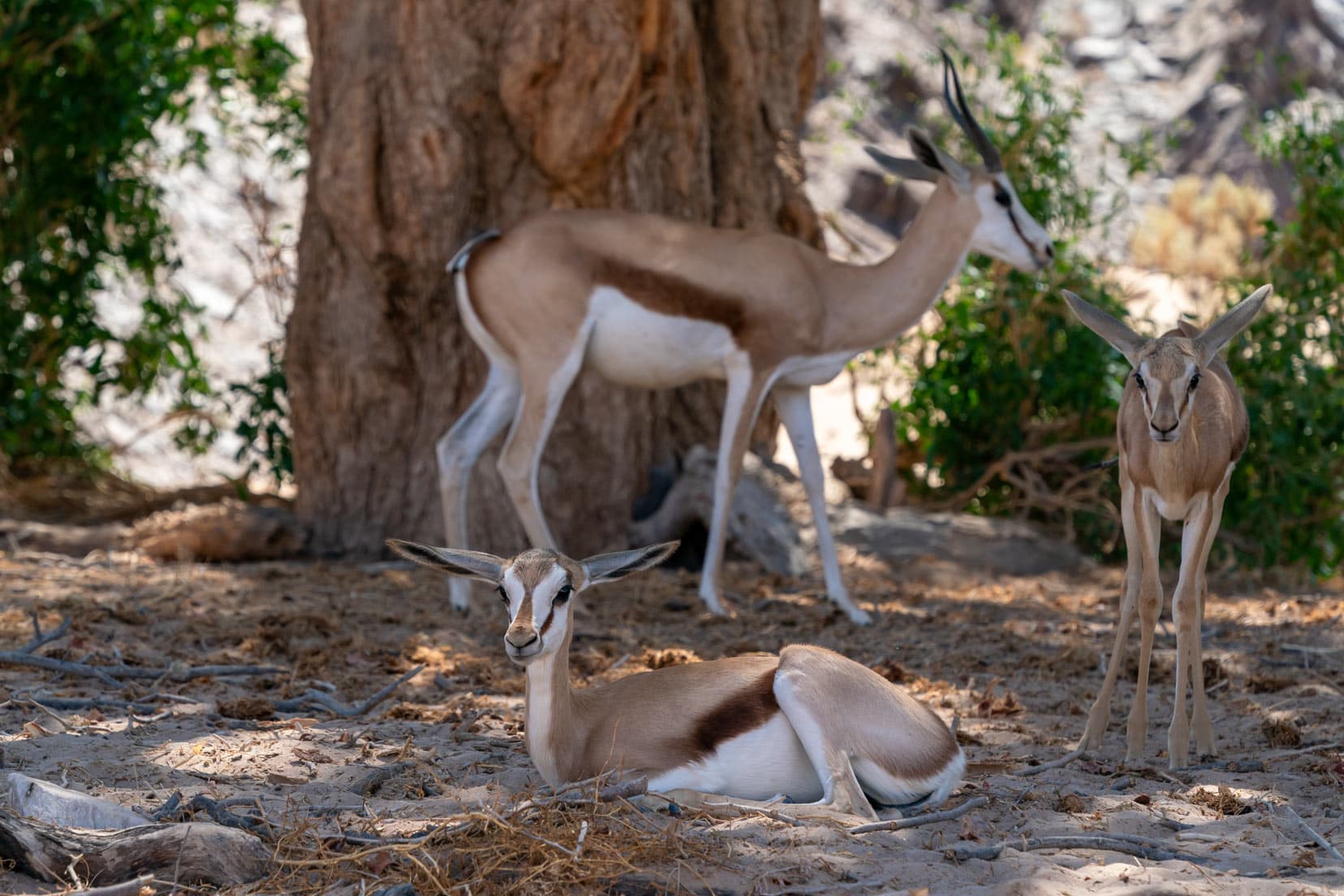
Baboons
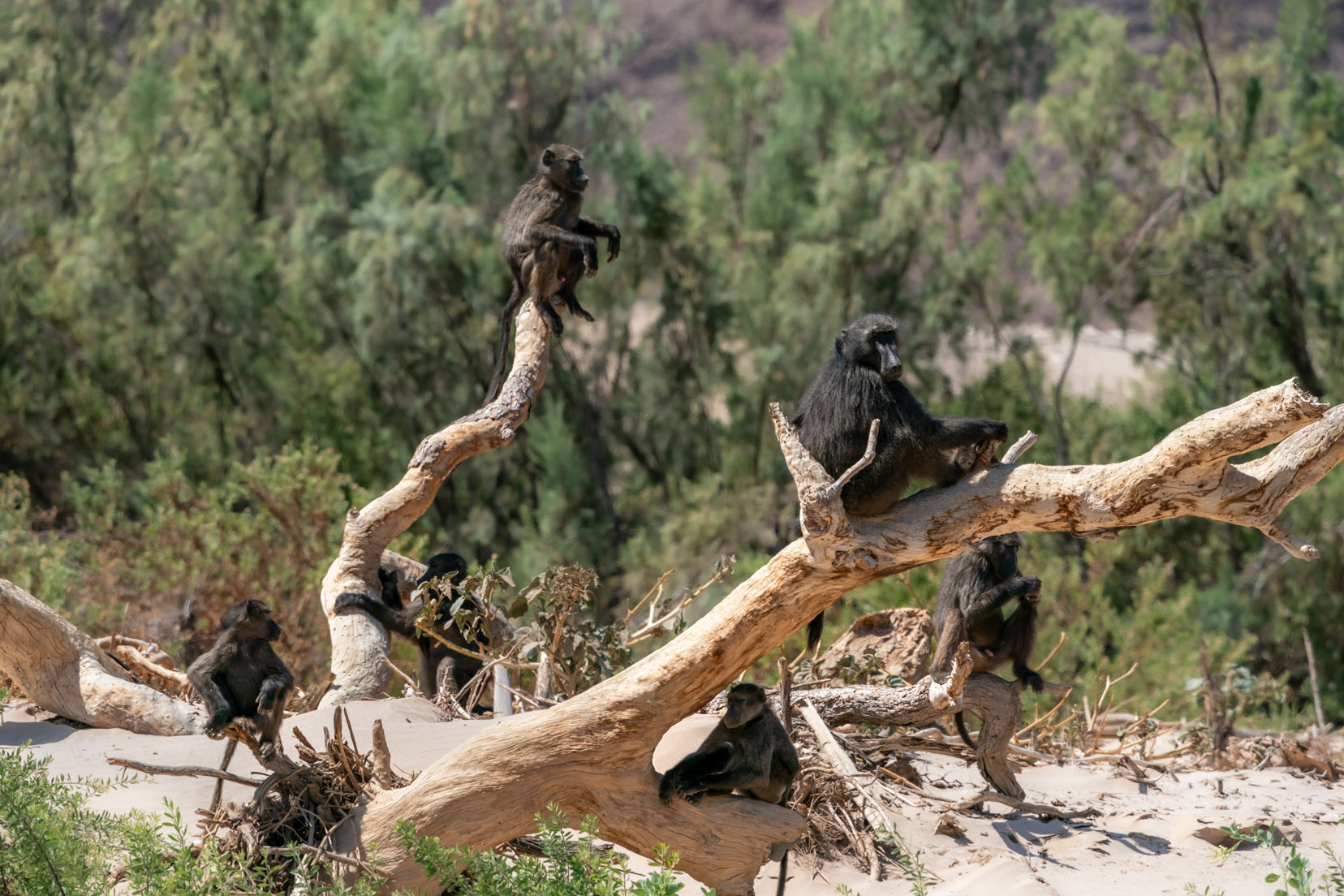
Ostrich
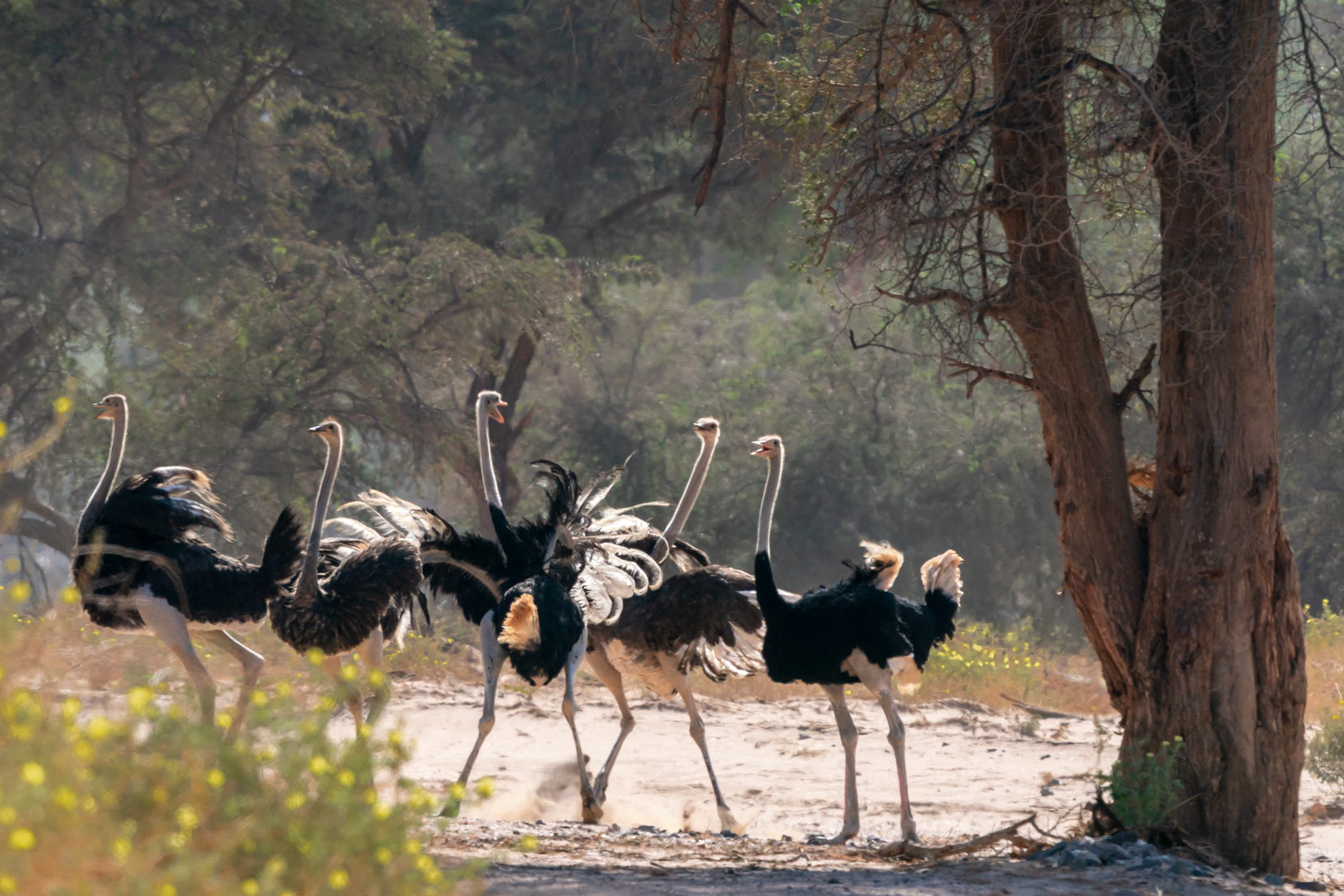
If you are a wildlife lover, then enhance your wildlife experiences with a Living Desert Tour in Swakopmund. There, you learn all about the small animals that have adapted to survive in the incredible Namib Desert.
Where to Find Desert Elephants in Namibia…That’s a Wrap
In the heart of the formidable Namibian desert, an environment that tests the limits of survival, the desert elephants have found a way to thrive.
This quest to witness these magnificent creatures in their natural habitat offers more than a unique adventure; it’s a deeply moving and enriching experience.
Our journey through this stark yet beautiful landscape has left us with unforgettable memories and a profound respect for these gentle giants and the delicate balance of their ecosystem.
We’re always here to answer your questions or hear about your experiences. Feel free to share your thoughts and stories in the comments below or get in touch with us directly.
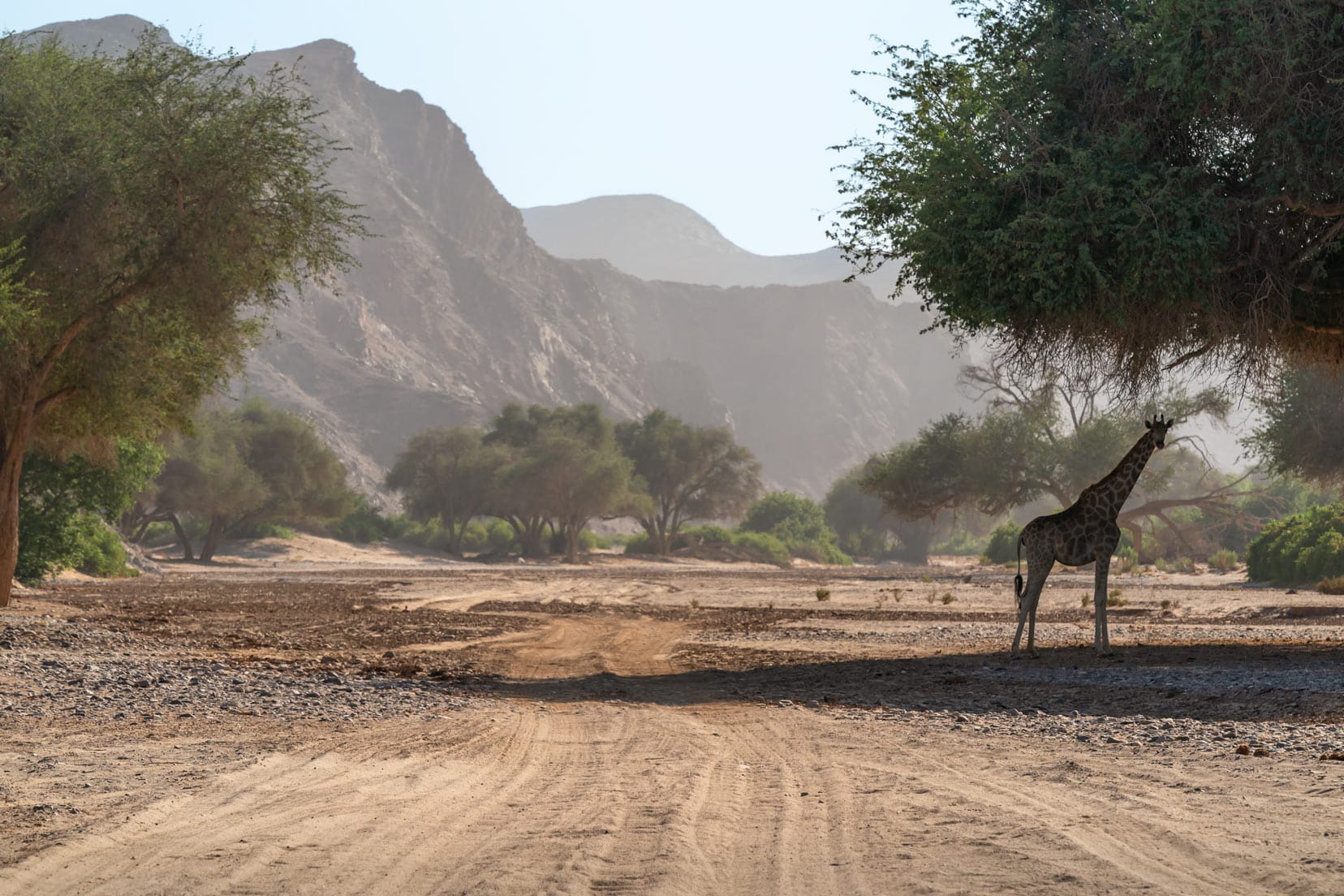
Pin and save for Later

Planning Your Travels?
These are the travel resources we recommend and use when planning our trips.
- 🚘 Car Hire: We use DiscoverCars.com
- Motorhome/Campervan Rental: We highly recommend the Motorhome Republic
- 🪪 Order your International Driver’s Licence online here
- 🛏 Book Accommodation: We use Booking.com to find accommodation that suits our budget
- 🐶 Pet Sitting/Pet Sitters: Check Out TrustedHousesitters here (Use our Discount code: LIFEJOURNEY25 for 25% off. )
- Activities and Experiences: Get Your Guide and Viator
- Travel Insurance: Safetywing or World Nomads
- 🥾 Travel Gear and Accessories: Check out our top picks here — Lifejourney4two page on Amazon
For a more thorough list, visit our Travel Resources page here.


errr…. nice article. But your photo of an Impala isn’t an Impala. You might want to fix the caption 😉
Hi Mike – thanks and glad you enjoyed the read. Oops! I’ve now made the correction. 😃
Enjoyed reading your piece on the elephant. Safe journeys and good health on your travels regards Dave
Hi David,
Glad you enjoyed the article. Thanks for your best wishes and the same back to you.
Warm Regards,
Lars